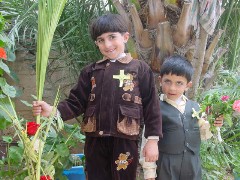 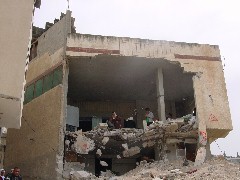 The
sounds of Zababdeh: The
sounds of Zababdeh:
4:30 AM, Rooster (3 sec.) 4:45 AM, Muslim prayer (40 sec.) 6:00 AM, Church bells (40 sec.) 6:30 AM, sheep 7:30 AM, National Anthem (40 sec.) 18 hrs./day, Generator (5 sec.) Night-time, shooting (5 sec.) |
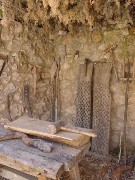 Wednesday,
5/1/02: Marthame continued running errands in the Galilee while
Elizabeth taught her kids before the coming Holy Week holidays (Eastern
calendar prevails for Easter in Zababdeh). Marthame paid a visit
to Nazareth Village, a ministry
of the local Nazareth YMCA. Some years ago, a Nazareth Christian
communicated his interest in building a place that would draw Christian
pilgrims, teach them something about the life of Christ, and to share the
gospel. Nazareth Village is the result - a reconstruction-in-progress
of Jesus-era Nazareth. Not many tourists are coming these days, so
Marthame had a private tour given by a Russian Messianic Jew. The
most powerful thing was seeing things pointed out in the tour which are
still in practice in Zababdeh - most notably efforts of water conversation
in the desert. We had planned for Elizabeth to come tomorrow, but
after a look at the upcoming Jerusalem Holy Week schedule, we changed our
minds so she wouldn't miss anything. We both rushed to coordinate
a rendevouz, and everything graciously came together (as things rarely
do here) - subhan allah (the wonders of God). We had to wait
a few minutes at the Jalame checkpoint, as a possible bomb threat was being
investigated on the settler road. Within a few minutes everything
was clear, and we headed up to spend the night in Nazareth. Wednesday,
5/1/02: Marthame continued running errands in the Galilee while
Elizabeth taught her kids before the coming Holy Week holidays (Eastern
calendar prevails for Easter in Zababdeh). Marthame paid a visit
to Nazareth Village, a ministry
of the local Nazareth YMCA. Some years ago, a Nazareth Christian
communicated his interest in building a place that would draw Christian
pilgrims, teach them something about the life of Christ, and to share the
gospel. Nazareth Village is the result - a reconstruction-in-progress
of Jesus-era Nazareth. Not many tourists are coming these days, so
Marthame had a private tour given by a Russian Messianic Jew. The
most powerful thing was seeing things pointed out in the tour which are
still in practice in Zababdeh - most notably efforts of water conversation
in the desert. We had planned for Elizabeth to come tomorrow, but
after a look at the upcoming Jerusalem Holy Week schedule, we changed our
minds so she wouldn't miss anything. We both rushed to coordinate
a rendevouz, and everything graciously came together (as things rarely
do here) - subhan allah (the wonders of God). We had to wait
a few minutes at the Jalame checkpoint, as a possible bomb threat was being
investigated on the settler road. Within a few minutes everything
was clear, and we headed up to spend the night in Nazareth. |
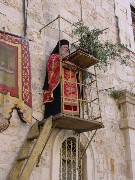 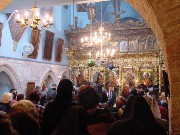 Thursday,
5/2/02: Maundy Thursday. We left Nazareth at five in the
morning to arrive in time for our first taste of Orthodox Holy Week festivities
in Jerusalem. We entered Mar Yacoub (St. James) Orthodox Church,
the Arab congregation of the Holy Sepulchre, named after the pillar of
the Jerusalem church. As the faithful processed forward for the eucharist,
preparations were being made for the Greek Orthodox liturgy of footwashing
in the Courtyard of the Holy Sepulchre. Our friend rushed us up to
the roof of the Greek Convent for a spectacular view of the raised platform
- Patriarch Irenaeus and twelve priests and archimandrites entered from
St. James' Church to the Yard. The liturgy calls for a retelling
of the footwashing before the Last Supper. The Patriarch removed
much of his more extravagant liturgical garb and tied a towel around his
waist, kneeling down to wash the feet of the twelve "disciples."
But for the two assistants doing much of the work, it was quite the image
of service. Each of the "disciples" then posed a question to "Jesus",
who responded in kind. Wish we could've understood the Greek.
We headed up to the Greek Orthodox Patriarchate afterwards to see if they
had anything to deliver to Zababdeh, Thursday,
5/2/02: Maundy Thursday. We left Nazareth at five in the
morning to arrive in time for our first taste of Orthodox Holy Week festivities
in Jerusalem. We entered Mar Yacoub (St. James) Orthodox Church,
the Arab congregation of the Holy Sepulchre, named after the pillar of
the Jerusalem church. As the faithful processed forward for the eucharist,
preparations were being made for the Greek Orthodox liturgy of footwashing
in the Courtyard of the Holy Sepulchre. Our friend rushed us up to
the roof of the Greek Convent for a spectacular view of the raised platform
- Patriarch Irenaeus and twelve priests and archimandrites entered from
St. James' Church to the Yard. The liturgy calls for a retelling
of the footwashing before the Last Supper. The Patriarch removed
much of his more extravagant liturgical garb and tied a towel around his
waist, kneeling down to wash the feet of the twelve "disciples."
But for the two assistants doing much of the work, it was quite the image
of service. Each of the "disciples" then posed a question to "Jesus",
who responded in kind. Wish we could've understood the Greek.
We headed up to the Greek Orthodox Patriarchate afterwards to see if they
had anything to deliver to Zababdeh, 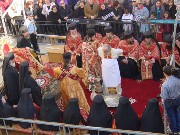 helped
by an Australian volunteer we met who is considering a call to the monastic
life. The priests in charge seemed quite dumbfounded why they should
be sending anything to their priest by way of Protestants. We did
get to greet the Patriarch, who seemed pleased by our helped
by an Australian volunteer we met who is considering a call to the monastic
life. The priests in charge seemed quite dumbfounded why they should
be sending anything to their priest by way of Protestants. We did
get to greet the Patriarch, who seemed pleased by our  presence
in Zababdeh. He asked us where we were from, and with a grin shared that
he had been in Chicago in 1961. He blessed some candles we will bring
to Abuna To'mie back in Zababdeh. We got a chance to visit with Bishop
Timotheus, who was happy to see us, and will hopefully come back to Tubas,
Burqin,
and Zababdeh soon. We then headed up to the roof of the Holy Sepulchre,
where the Copts (Egyptian and Ethiopian Orthodox) have their monasteries.
The Ethiopians had set up a tent for worship, and pilgrims had come from
that historic country for the feast. There, we bumped into a friend who
works as a tour operator/guide. She commented that most years, there are
so many Ethiopian pilgrims that it is difficult to even got to the roof.
(She also said that last year her firm lost a lot of Ethiopian business
because Israel started to grant visas preferentially to groups who booked
tours with Jewish - rather than Arab - Israeli operators.) Ethiopians have
strong connections with all three faiths of this land - Mohammed said that
Ethiopians were unparalleled among the nations; one of the first converts
to Christianity presence
in Zababdeh. He asked us where we were from, and with a grin shared that
he had been in Chicago in 1961. He blessed some candles we will bring
to Abuna To'mie back in Zababdeh. We got a chance to visit with Bishop
Timotheus, who was happy to see us, and will hopefully come back to Tubas,
Burqin,
and Zababdeh soon. We then headed up to the roof of the Holy Sepulchre,
where the Copts (Egyptian and Ethiopian Orthodox) have their monasteries.
The Ethiopians had set up a tent for worship, and pilgrims had come from
that historic country for the feast. There, we bumped into a friend who
works as a tour operator/guide. She commented that most years, there are
so many Ethiopian pilgrims that it is difficult to even got to the roof.
(She also said that last year her firm lost a lot of Ethiopian business
because Israel started to grant visas preferentially to groups who booked
tours with Jewish - rather than Arab - Israeli operators.) Ethiopians have
strong connections with all three faiths of this land - Mohammed said that
Ethiopians were unparalleled among the nations; one of the first converts
to Christianity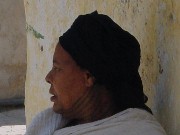 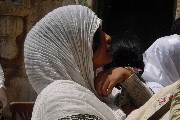 was the Ethiopian eunuch baptized by Philip (Acts 8); and the kings of
Ethiopia traced their lineage back to Solomon via the Queen of Sheba (I
Kings 10). The liturgy, music, and language were in complete contrast
to the Greeks, with a call and response prayer which was quite ethereal
(audio - 7 sec.). The tent was packed
with the faithful, most wrapped in white muslin cloth, many with tattoos
on their hands (and some on their necks). We were too tired to stay,
but were told that the footwashing is done by the head of the local church
using grape leaves, which he then uses at the end to bless the congregation
with water - much needed after standing in a tent on the roof for a couple
of hours. We checked in with our hosts in
was the Ethiopian eunuch baptized by Philip (Acts 8); and the kings of
Ethiopia traced their lineage back to Solomon via the Queen of Sheba (I
Kings 10). The liturgy, music, and language were in complete contrast
to the Greeks, with a call and response prayer which was quite ethereal
(audio - 7 sec.). The tent was packed
with the faithful, most wrapped in white muslin cloth, many with tattoos
on their hands (and some on their necks). We were too tired to stay,
but were told that the footwashing is done by the head of the local church
using grape leaves, which he then uses at the end to bless the congregation
with water - much needed after standing in a tent on the roof for a couple
of hours. We checked in with our hosts in 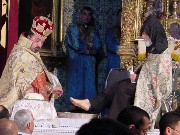 Jerusalem
before heading off to footwashing service number three, this time at the
Armenian Patriarchate Cathedral of St. James. The Armenians have
had a continuous presence in Jerusalem for centuries, one of the Quarters
of the Old City being Armenian. Their numbers swelled after the 1915
Armenian Genocide in Turkey, reminders of which plaster the walls of their
Quarter. They also have a seminary in Jerusalem
before heading off to footwashing service number three, this time at the
Armenian Patriarchate Cathedral of St. James. The Armenians have
had a continuous presence in Jerusalem for centuries, one of the Quarters
of the Old City being Armenian. Their numbers swelled after the 1915
Armenian Genocide in Turkey, reminders of which plaster the walls of their
Quarter. They also have a seminary in 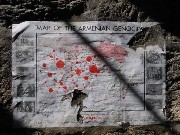 the
city whose choir is second to none in presenting beautiful liturgical music
(video - 25 sec.). We have been in
this elegant, mystery-laden church several
times before, and it is always a treat to return. It was interesting
to see the Anglican Bishop of Jerusalem participating in the service, a
tradition that goes back to the 1920s when the Brits sent an Anglican priest
to work on ecumenical relations. He was quite successful apparently
(at least with the Armenians), leading to strong ties which are still maintained.
After the service we visited with friends from the Anglican community,
including those with Sabeel, who are
hoping to bring a group to Zababdeh soon. We met one of the Armenian
priests who was eager to share his current research, that Christ's resurrection
took place in his incarnate body, the theological significance such that
humans are bound up in the defeat of death. Sometimes it seems that
only among the Orthodox will you still find such conversations about doctrine
taking place. We joined our friends in East Jerusalem for grilled
brats and Taybeh beer - not exactly an
Orthodox fast, but certainly a rare taste of pork for us these days... the
city whose choir is second to none in presenting beautiful liturgical music
(video - 25 sec.). We have been in
this elegant, mystery-laden church several
times before, and it is always a treat to return. It was interesting
to see the Anglican Bishop of Jerusalem participating in the service, a
tradition that goes back to the 1920s when the Brits sent an Anglican priest
to work on ecumenical relations. He was quite successful apparently
(at least with the Armenians), leading to strong ties which are still maintained.
After the service we visited with friends from the Anglican community,
including those with Sabeel, who are
hoping to bring a group to Zababdeh soon. We met one of the Armenian
priests who was eager to share his current research, that Christ's resurrection
took place in his incarnate body, the theological significance such that
humans are bound up in the defeat of death. Sometimes it seems that
only among the Orthodox will you still find such conversations about doctrine
taking place. We joined our friends in East Jerusalem for grilled
brats and Taybeh beer - not exactly an
Orthodox fast, but certainly a rare taste of pork for us these days... |
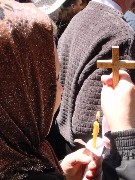 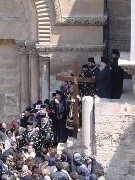 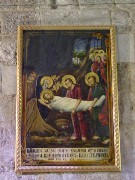 Friday,
5/3/02: Good Friday. We joined the Greek procession along
the via dolorosa late - the times on the schedule are quite confusing.
All times listed within the Holy Sepulchre actually take place one hour
later, the Holy Sepulchre not recognizing the "springing forward".
In any case, finding a large group of hymn-singing, cross-and-candle-bearing
pilgrims was not difficult (video - 7 sec.),
and we soon caught up. This year, because of the political uncertainties,
the crowd isn't as big as usual, but it is difficult to imagine what a
"usual" year is like among the narrow, winding Old City streets.
For the first time since we came here, the vendors along the road look
somewhat busy. The procession made its way to the Holy Sepulchre,
where the cross was carried to the Greek Orthodox chapel in Golgotha in
remembrance of the Crucifixion. The crowds rushed to get upstairs,
which Elizabeth and a friend of ours decided to forego. The pushing
and jostling for position reminded Marthame of punk rock concerts in college
- not exactly a forum for piety. We met up with our new Australian
Orthodox friend, who explained to us the theological significance of icons
- to deny them as merely "graven images" (as several iconoclastic periods
in the church - including the Reformation - did) is to deny the possibility
of the incarnation. Theological conversations abound...After lunch
in the Old City, we headed up to the Russian Church of the Holy Trinity
in West Jerusalem. Historically, it was connected with the "Red"
churches, those that cooperated with the Communist regime. There
is also a "White" Russian church community here, St.
Mary Magdalene's convent on the Mount of Olives. We were told that
a few years ago, the Russian Orthodox Patriarch came from Moscow to Jerusalem
and went to visit the "White" church community at the convent. They refused
to open the doors to him - such is the animosity within the Russian Orthodox
community. Friday,
5/3/02: Good Friday. We joined the Greek procession along
the via dolorosa late - the times on the schedule are quite confusing.
All times listed within the Holy Sepulchre actually take place one hour
later, the Holy Sepulchre not recognizing the "springing forward".
In any case, finding a large group of hymn-singing, cross-and-candle-bearing
pilgrims was not difficult (video - 7 sec.),
and we soon caught up. This year, because of the political uncertainties,
the crowd isn't as big as usual, but it is difficult to imagine what a
"usual" year is like among the narrow, winding Old City streets.
For the first time since we came here, the vendors along the road look
somewhat busy. The procession made its way to the Holy Sepulchre,
where the cross was carried to the Greek Orthodox chapel in Golgotha in
remembrance of the Crucifixion. The crowds rushed to get upstairs,
which Elizabeth and a friend of ours decided to forego. The pushing
and jostling for position reminded Marthame of punk rock concerts in college
- not exactly a forum for piety. We met up with our new Australian
Orthodox friend, who explained to us the theological significance of icons
- to deny them as merely "graven images" (as several iconoclastic periods
in the church - including the Reformation - did) is to deny the possibility
of the incarnation. Theological conversations abound...After lunch
in the Old City, we headed up to the Russian Church of the Holy Trinity
in West Jerusalem. Historically, it was connected with the "Red"
churches, those that cooperated with the Communist regime. There
is also a "White" Russian church community here, St.
Mary Magdalene's convent on the Mount of Olives. We were told that
a few years ago, the Russian Orthodox Patriarch came from Moscow to Jerusalem
and went to visit the "White" church community at the convent. They refused
to open the doors to him - such is the animosity within the Russian Orthodox
community. 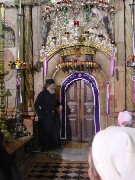 The
Church of the Holy Trinity was more sunlit The
Church of the Holy Trinity was more sunlit 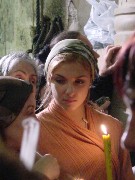 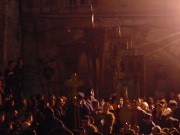 and
less gold-laden than we expected. We weren't allowed to take pictures
within this church (which is normally closed), but were able to capture
some of the elegant liturgical music offered by a women's choir - it's
unusual to hear women's voices in Orthodox worship here (audio
- 5 sec.). After a short recovery nap, we headed back to the Holy
Sepulchre for the Orthodox "Burial of Christ". After processing around
the Holy Sepulchre Courtyard with a representation of Christ's body held
in a carpet (and covered in flower petals), the Greek Bishops and Patriarch
enter the Church. Wherever church leaders go, they are lead by two
or three "openers" - men in fezzes pounding long silver-topped walking
sticks on the heavy stones to clear the way - a tradition left over from
the time of the Ottoman Turkish period. We were able to get a spot
right next to the sepulchre itself, sharing the crowded space with Romanians
and other Orthodox faithful. We couldn't see much, though, particularly
due to the number of TV cameras and photo media present (as well as dignitaries
from the Greek Consulate). We also didn't understand much of the
liturgy (since it was in Greek), but at about 1:30 in the morning we thought
that they were almost finished. That's when we noticed that they
were only halfway through their prayer books. We went home; we clearly
don't have the endurance to be high, high church Orthodox. and
less gold-laden than we expected. We weren't allowed to take pictures
within this church (which is normally closed), but were able to capture
some of the elegant liturgical music offered by a women's choir - it's
unusual to hear women's voices in Orthodox worship here (audio
- 5 sec.). After a short recovery nap, we headed back to the Holy
Sepulchre for the Orthodox "Burial of Christ". After processing around
the Holy Sepulchre Courtyard with a representation of Christ's body held
in a carpet (and covered in flower petals), the Greek Bishops and Patriarch
enter the Church. Wherever church leaders go, they are lead by two
or three "openers" - men in fezzes pounding long silver-topped walking
sticks on the heavy stones to clear the way - a tradition left over from
the time of the Ottoman Turkish period. We were able to get a spot
right next to the sepulchre itself, sharing the crowded space with Romanians
and other Orthodox faithful. We couldn't see much, though, particularly
due to the number of TV cameras and photo media present (as well as dignitaries
from the Greek Consulate). We also didn't understand much of the
liturgy (since it was in Greek), but at about 1:30 in the morning we thought
that they were almost finished. That's when we noticed that they
were only halfway through their prayer books. We went home; we clearly
don't have the endurance to be high, high church Orthodox. |
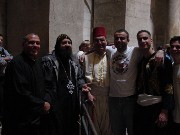 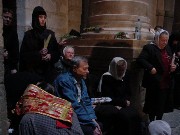 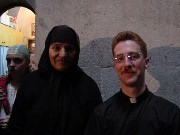 Saturday,
5/4/02: Holy Saturday, or
sabt in-nour (Saturday of Light).
We arrived at the Holy Sepulchre at 11:00 in the morning for the liturgy
of the Holy Fire. Thanks to the Armenian Patriarchate (and the lack
of pilgrim crowds), we got passes to be inside the church for the service.
We were waiting with some of the ex-pat Anglican community, as well as
a small group of Ukrainian Orthodox accompanied by several priests and
nuns. We visited with Sister Anna, a Romanian nun serving in the
Greek Orthodox Patriarchate, who was happy to help explain things to us
and to share her seat for some much-needed foot relief. The first
procession belonged to the Arab Orthodox community. A group of young
men entered the church playing drums and chanting enthusiastically.
It was very familiar to us, but contrasted greatly with the severity of
the Greek liturgies of these days. At about 2:00, the bells rang
33 times (for each year of Christ's life), signaling the arrival of the
Greek procession. Saturday,
5/4/02: Holy Saturday, or
sabt in-nour (Saturday of Light).
We arrived at the Holy Sepulchre at 11:00 in the morning for the liturgy
of the Holy Fire. Thanks to the Armenian Patriarchate (and the lack
of pilgrim crowds), we got passes to be inside the church for the service.
We were waiting with some of the ex-pat Anglican community, as well as
a small group of Ukrainian Orthodox accompanied by several priests and
nuns. We visited with Sister Anna, a Romanian nun serving in the
Greek Orthodox Patriarchate, who was happy to help explain things to us
and to share her seat for some much-needed foot relief. The first
procession belonged to the Arab Orthodox community. A group of young
men entered the church playing drums and chanting enthusiastically.
It was very familiar to us, but contrasted greatly with the severity of
the Greek liturgies of these days. At about 2:00, the bells rang
33 times (for each year of Christ's life), signaling the arrival of the
Greek procession. 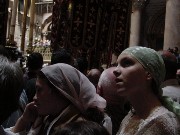 They
processed around the Sepulchre three They
processed around the Sepulchre three 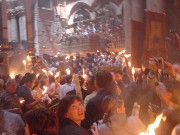 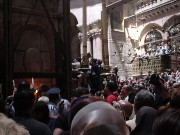 times
(a symbol of the Trinity, and a common practice in Orthodox services) carrying
banners. The faithful were anxious to touch the banners and receive
blessings from them, touching their bundles of 33 candles to them.
Orthodox tradition holds that the Greek Patriarch enters the Holy Sepulchre
on Saturday accompanied by a couple of witnesses with an unlit candle.
He lays the candle of the stone of the tomb. After a while, light
shoots through a crack in the stone (which the truly believing can see
like bluish lightning in the Church), miraculously lighting the candle,
which is then passed throughout the church - the "Holy Fire" is also brought
to other Orthodox Patriarchs (delivered by lantern and plane these days)
to share this miracle. While we were not faithful enough to see the
flash, there was no mistaking the arrival of the light. A great,
loud cheer went up, and the bells began to peel (audio
- 12 sec., video - 12 sec.). The
fire times
(a symbol of the Trinity, and a common practice in Orthodox services) carrying
banners. The faithful were anxious to touch the banners and receive
blessings from them, touching their bundles of 33 candles to them.
Orthodox tradition holds that the Greek Patriarch enters the Holy Sepulchre
on Saturday accompanied by a couple of witnesses with an unlit candle.
He lays the candle of the stone of the tomb. After a while, light
shoots through a crack in the stone (which the truly believing can see
like bluish lightning in the Church), miraculously lighting the candle,
which is then passed throughout the church - the "Holy Fire" is also brought
to other Orthodox Patriarchs (delivered by lantern and plane these days)
to share this miracle. While we were not faithful enough to see the
flash, there was no mistaking the arrival of the light. A great,
loud cheer went up, and the bells began to peel (audio
- 12 sec., video - 12 sec.). The
fire 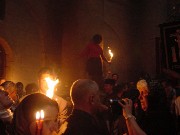 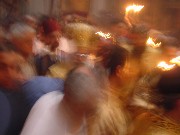 quickly
passed throughout the Church, from one bundle to another (33 candles together
make quite a torch). It was, at the same moment, thrilling, moving, and
terrifying, as we were tightly-packed in with very enthusiastic people
jumping and cheering with big sticks of fire. Fortunately, after a few
minutes, everyone put out their big packs of candles, a few people keeping
small single candles lit. The Ukrainians were noticeably moved, touching
their hands to the fire and rubbing their faces. We had wanted to
burn Abuna Tom'ie's candles with the Holy Fire, but had left them back
with our friends in East Jerusalem. We were able to transport the
fire (from candle to candle) as we walked across the Old City, through
a visit with friends in West Jerusalem (thanks to a tea candle) and for
the car ride back to Abuna Tom'ie's candles. quickly
passed throughout the Church, from one bundle to another (33 candles together
make quite a torch). It was, at the same moment, thrilling, moving, and
terrifying, as we were tightly-packed in with very enthusiastic people
jumping and cheering with big sticks of fire. Fortunately, after a few
minutes, everyone put out their big packs of candles, a few people keeping
small single candles lit. The Ukrainians were noticeably moved, touching
their hands to the fire and rubbing their faces. We had wanted to
burn Abuna Tom'ie's candles with the Holy Fire, but had left them back
with our friends in East Jerusalem. We were able to transport the
fire (from candle to candle) as we walked across the Old City, through
a visit with friends in West Jerusalem (thanks to a tea candle) and for
the car ride back to Abuna Tom'ie's candles. 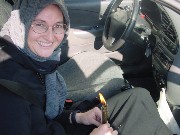 Clothes
and arms coated in hot wax was the price, but Marthame's arms were already
too hairy. After supper, we headed back to the Holy Sepulchre to
see the Ethiopian procession of the Holy Fire, which is markedly African
in contrast to the Greeks. We headed up the stairs from the Courtyard,
passing through the Ethiopian churches. Pilgrims cloaked in white
were packed in there, looking as though they may have been sleeping there
for a couple of days. After worship in the tent on the roof, the
community processes Clothes
and arms coated in hot wax was the price, but Marthame's arms were already
too hairy. After supper, we headed back to the Holy Sepulchre to
see the Ethiopian procession of the Holy Fire, which is markedly African
in contrast to the Greeks. We headed up the stairs from the Courtyard,
passing through the Ethiopian churches. Pilgrims cloaked in white
were packed in there, looking as though they may have been sleeping there
for a couple of days. After worship in the tent on the roof, the
community processes 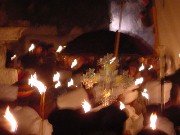 around
the rotunda three times. The church's Custos (equivalent of a Bishop)
is under a bejeweled umbrella in the midst of the procession, which quickly
becomes one of drumming, singing, and dancing (video
- 14 sec.). Many Arab Jerusalemites come to see this, apparently
one of the most popular events of Holy Week. We headed back to Nazareth,
deciding to forego the Greek Easter Vigil, so that we could return to Zababdeh
in the morning in time for worship. around
the rotunda three times. The church's Custos (equivalent of a Bishop)
is under a bejeweled umbrella in the midst of the procession, which quickly
becomes one of drumming, singing, and dancing (video
- 14 sec.). Many Arab Jerusalemites come to see this, apparently
one of the most popular events of Holy Week. We headed back to Nazareth,
deciding to forego the Greek Easter Vigil, so that we could return to Zababdeh
in the morning in time for worship. |
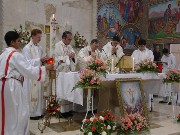 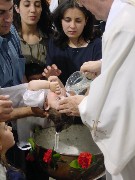 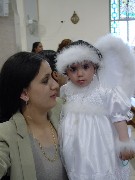 Sunday,
5/5/02: Al-Masih Qam. Haqan Qam. (Christ is
Risen. He is risen indeed) We made it back to Zababdeh via
our now-usual two taxi run - one from Nazareth to Jalame, the other from
Jalame to Zababdeh. Tank treads were on the road, evidence of a late
night visit through Zababdeh. We arrived in time to join Abuna Aktham
and the Latin Church of Visitation for Easter morning services (video
- 12 sec.). The Bishop of Nazareth, Boulos Marcuzzo, joined us this
morning, as did two other priests of the Patriarchate. Marcuzzo is
the bishop who came to Zababdeh last year for a visit and the Israeli army
fired
on his car. Fortunately, no such excitement this time; he (and
we) arrived without incident. In the Latin community, Easter is the
day for baptisms, a potent symbol of the Resurrection. Twenty-one
children were baptized today, one after another, following the Mass.
It was fun to see all of the kids dressed in their newest, whitest clothes,
accompanied by their extended families (which meant the church was almost
as packed as it usually is for Sunday worship). Sunday,
5/5/02: Al-Masih Qam. Haqan Qam. (Christ is
Risen. He is risen indeed) We made it back to Zababdeh via
our now-usual two taxi run - one from Nazareth to Jalame, the other from
Jalame to Zababdeh. Tank treads were on the road, evidence of a late
night visit through Zababdeh. We arrived in time to join Abuna Aktham
and the Latin Church of Visitation for Easter morning services (video
- 12 sec.). The Bishop of Nazareth, Boulos Marcuzzo, joined us this
morning, as did two other priests of the Patriarchate. Marcuzzo is
the bishop who came to Zababdeh last year for a visit and the Israeli army
fired
on his car. Fortunately, no such excitement this time; he (and
we) arrived without incident. In the Latin community, Easter is the
day for baptisms, a potent symbol of the Resurrection. Twenty-one
children were baptized today, one after another, following the Mass.
It was fun to see all of the kids dressed in their newest, whitest clothes,
accompanied by their extended families (which meant the church was almost
as packed as it usually is for Sunday worship). 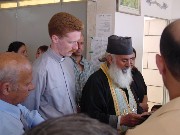 After
Bishop Marcuzzo anointed each of the children, they were brought forward
one by one, held over the font, where water was poured over their heads
- much more than a Presbyterian sprinkling. Not a single child left
without being brought to tears. Afterwards, everyone processes around
the altar (lot of processing going on these days). After
Bishop Marcuzzo anointed each of the children, they were brought forward
one by one, held over the font, where water was poured over their heads
- much more than a Presbyterian sprinkling. Not a single child left
without being brought to tears. Afterwards, everyone processes around
the altar (lot of processing going on these days). 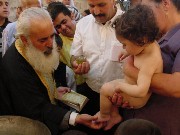 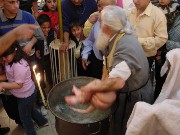 We
then joined the Bishop, as well as the Latin clergy from Zababadeh and
Jenin, for a magnificent Easter feast. Traditional Arabic Mansaaf
was followed by chicken and vegetables and, of course, the lamb.
People make up for lost meat-eating time here in style. Our four-day
marathon continued as we headed to the Orthodox Church for an early afternoon
baptism. Unlike the Latins, the Orthodox do not do multiple-baptisms
only (or mostly) on Easter. However, they do hold them as a separate
service. There were many details to follow in the liturgy.
Marthame stood with Abuna To'mie as the child's God-father held young George.
Abuna blew on the child's forehead, as he and the family symbolically rejected We
then joined the Bishop, as well as the Latin clergy from Zababadeh and
Jenin, for a magnificent Easter feast. Traditional Arabic Mansaaf
was followed by chicken and vegetables and, of course, the lamb.
People make up for lost meat-eating time here in style. Our four-day
marathon continued as we headed to the Orthodox Church for an early afternoon
baptism. Unlike the Latins, the Orthodox do not do multiple-baptisms
only (or mostly) on Easter. However, they do hold them as a separate
service. There were many details to follow in the liturgy.
Marthame stood with Abuna To'mie as the child's God-father held young George.
Abuna blew on the child's forehead, as he and the family symbolically rejected 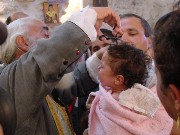 Satan.
Then a large copper basin was filled with cold water (Abuna was very specific
about the temperature). A cup of blessed olive oil was put into the
basin (video - 9 sec.), but first young
naked George was anointed: his eyes to see God's work, his nose to smell
the scent of Christ, his mouth to speak God's wisdom, his ears to hear
the word of Christ, his chest for the health Satan.
Then a large copper basin was filled with cold water (Abuna was very specific
about the temperature). A cup of blessed olive oil was put into the
basin (video - 9 sec.), but first young
naked George was anointed: his eyes to see God's work, his nose to smell
the scent of Christ, his mouth to speak God's wisdom, his ears to hear
the word of Christ, his chest for the health 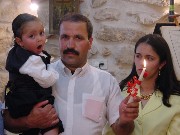 of
his body, his hands to do God's work, his feet to tread the head of the
serpent (a reference to evil), his back to carry his cross. Then
the moment for which Orthodox baptisms are famous - young George was dunked
into the water three times, a traumatic moment to say the least.
Somehow, though, it seems fitting - first of all, that the child is (in
the words of Paul - Romans 6) "buried with Christ" in baptism, and that
the entry into the Christian community of faith is a jolting one.
Abuna cut locks of hair from the front, back, and two sides of George's
hair, blessing his head in the sign of the cross. Finally, one last
procession to round out our week. We visited with Abuna To'mie later
in the evening to bring him the candles and greetings from Bishop Timotheus.
He was appreciative. His wife asked why Marthame didn't just become
an Orthodox priest, especially after such a week. We said it'd be
better to bring the rest of the Presbyterian Church with us rather than
abandoning them to their Protestant ways like lost sheep. They laughlingly
agreed we should stay and suffer with our Calvinist brothers and sisters. of
his body, his hands to do God's work, his feet to tread the head of the
serpent (a reference to evil), his back to carry his cross. Then
the moment for which Orthodox baptisms are famous - young George was dunked
into the water three times, a traumatic moment to say the least.
Somehow, though, it seems fitting - first of all, that the child is (in
the words of Paul - Romans 6) "buried with Christ" in baptism, and that
the entry into the Christian community of faith is a jolting one.
Abuna cut locks of hair from the front, back, and two sides of George's
hair, blessing his head in the sign of the cross. Finally, one last
procession to round out our week. We visited with Abuna To'mie later
in the evening to bring him the candles and greetings from Bishop Timotheus.
He was appreciative. His wife asked why Marthame didn't just become
an Orthodox priest, especially after such a week. We said it'd be
better to bring the rest of the Presbyterian Church with us rather than
abandoning them to their Protestant ways like lost sheep. They laughlingly
agreed we should stay and suffer with our Calvinist brothers and sisters. |
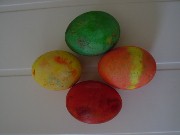 Monday,
5/6/02: We waded through the 200 emails in our inbox, and lazed
about enjoying a day without school to recover. We then headed off
to Qabatiya, a nearby village which is home to many of our students and
teachers. Yesterday, a mother and her two children were planting
in the fields on the road to Qabatiya when an Israeli tank arrived to investigate
a mine that had been planted. The family, frightened by the presence
of a tank, fled. They were shot and killed as they ran because they
were "suspicious." The Israeli army apologized, but this is not an
isolated incident - a number of "accidental" killings have happened over
the past year and a half (not to mention over the 35 years of Israeli Occupation),
further fueling anti-Israeli sentiment in this area. Fortunately
for us, today the way to Qabatiya was clear, so we were able to visit with
two students from our school and their family. Their mother is a
Romanian Christian, and their father is a Palestinian Muslim. They
have found a way to strike a healthy balance at home, even within a culture
(both Christian and Muslim) that doesn't understand such a possibility.
We walked past the school where men of the town, including the older son
and the father were brought for "processing" by the Israeli army.
The last year and a half has really taken its toll on many families - theirs
is no exception. We spent a good day of conversation talking about
religion - gives one hope for conversations that could take place between
Christians and Muslims. We returned to Zababdeh to visit with families,
share Easter greetings, and eat eggs. Two tanks came on the road
towards Zababdeh, but turned off into the fields of chickpeas before entering
the village, ilhamdulillah. Monday,
5/6/02: We waded through the 200 emails in our inbox, and lazed
about enjoying a day without school to recover. We then headed off
to Qabatiya, a nearby village which is home to many of our students and
teachers. Yesterday, a mother and her two children were planting
in the fields on the road to Qabatiya when an Israeli tank arrived to investigate
a mine that had been planted. The family, frightened by the presence
of a tank, fled. They were shot and killed as they ran because they
were "suspicious." The Israeli army apologized, but this is not an
isolated incident - a number of "accidental" killings have happened over
the past year and a half (not to mention over the 35 years of Israeli Occupation),
further fueling anti-Israeli sentiment in this area. Fortunately
for us, today the way to Qabatiya was clear, so we were able to visit with
two students from our school and their family. Their mother is a
Romanian Christian, and their father is a Palestinian Muslim. They
have found a way to strike a healthy balance at home, even within a culture
(both Christian and Muslim) that doesn't understand such a possibility.
We walked past the school where men of the town, including the older son
and the father were brought for "processing" by the Israeli army.
The last year and a half has really taken its toll on many families - theirs
is no exception. We spent a good day of conversation talking about
religion - gives one hope for conversations that could take place between
Christians and Muslims. We returned to Zababdeh to visit with families,
share Easter greetings, and eat eggs. Two tanks came on the road
towards Zababdeh, but turned off into the fields of chickpeas before entering
the village, ilhamdulillah. |
|
Wednesday, 5/8/02: Late last night there was a suicide bombing in Israel - 16 killed, including the bomber. The images on the TV show a scene of incredible devastation. The feeling of horror is accompanied by the feeling of dread, not knowing what or where the Israeli response will be. Nonetheless, today the school was at full capacity. We've already lost a month (our Jenin students twice that), so everybody seems more determined than ever to roll ahead and salvage as much as possible of the school year. Marthame headed up to Jenin to get our new "business" cards printed (hard to believe we've gone through them all) and visit with one of our friends who works as a lawyer. She, like the local legal profession (except NGO-based legal/human rights workers), is at a stand-still, largely because people can't afford to use them. Ominously, the decimation of the Palestinian Authority, especially its police and civil infrastructure, threatens to leave people under a kind of Wild West justice, without the semblance of law, order, and due process they had attained. The anxiety in Jenin hung in the air as word spread about tanks on the road and helicopters overhead. Everyone was planning to go home early, including Marthame, who arrived home without incident. |
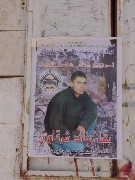 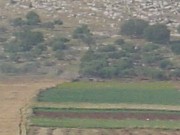 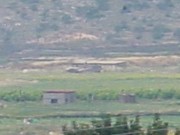 Thursday,
5/9/02: Zababdeh's "martyr" is found among the "martyr" posters
pasted up on walls and business doors around town. The big news at school
today was the tank parked out in the fields. The Israeli army has
a training camp next to Zababdeh (the scene of frequent shooting - either
practice or skirmishes, we're never sure, but unsettling nonetheless),
and during the recent incursions, tanks have been based out of the camp.
"Area A" designation (within which Zababdeh falls), created in Oslo for
Palestinian autonomous areas, has become largely irrelevent, and Israeli
tanks coming and going through the area is one clear sign of that.
This one was parked in somebody's field of hummous (the word not
only for chick pea dip, but also the beans themselves), an Israeli flag
prominently waving over it. Everyone is still nervous, but until
now, there's been no overwhelming reprisal for yesterday's attack - just
a bunch of little ones. The Bethlehem stand-off still continues,
with the bizarre twist of the Italians not knowing they were to receive
exiles. This also means that hundreds of people are stuck in their
homes nearby (including some friends of ours). Enough. Late
in the afternoon, as we sat out on our porch with a student from the University,
two tanks went rumbling along through the fields - the sound of their grinding
motors is unmistakable. They then headed up the hill, probably on
their way to Qabatiya. One isn't
sure of much these days. Thursday,
5/9/02: Zababdeh's "martyr" is found among the "martyr" posters
pasted up on walls and business doors around town. The big news at school
today was the tank parked out in the fields. The Israeli army has
a training camp next to Zababdeh (the scene of frequent shooting - either
practice or skirmishes, we're never sure, but unsettling nonetheless),
and during the recent incursions, tanks have been based out of the camp.
"Area A" designation (within which Zababdeh falls), created in Oslo for
Palestinian autonomous areas, has become largely irrelevent, and Israeli
tanks coming and going through the area is one clear sign of that.
This one was parked in somebody's field of hummous (the word not
only for chick pea dip, but also the beans themselves), an Israeli flag
prominently waving over it. Everyone is still nervous, but until
now, there's been no overwhelming reprisal for yesterday's attack - just
a bunch of little ones. The Bethlehem stand-off still continues,
with the bizarre twist of the Italians not knowing they were to receive
exiles. This also means that hundreds of people are stuck in their
homes nearby (including some friends of ours). Enough. Late
in the afternoon, as we sat out on our porch with a student from the University,
two tanks went rumbling along through the fields - the sound of their grinding
motors is unmistakable. They then headed up the hill, probably on
their way to Qabatiya. One isn't
sure of much these days. |
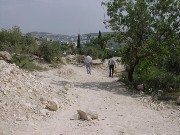 Friday
5/10/02: The Bethlehem situation is "resolved" finally, 26 going
to Gaza, 13 (at least one of whom is Christian) going to Friday
5/10/02: The Bethlehem situation is "resolved" finally, 26 going
to Gaza, 13 (at least one of whom is Christian) going to 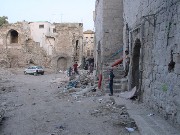 Cyprus
until exiled elsewhere in Europe, and the rest going home. The fate
of the internationals who brought food into the Church of the Nativity
a few weeks ago is less clear - they don't want to be arrested by Israel,
claiming that the nation has no sovereignty over the Church. There
was an attack in southern Israel, in Beersheva, this morning. Marthame
had planned to go off to Nablus to
visit with Father Hossam, and after much thinking, decided to go ahead.
Elizabeth didn't go because she probably couldn't make the trip and get
back in time for her class tomorrow. She spent much of the day doing lesson
plans and writing. Today being Friday (the Muslim day of prayer) and the
situation being what it is, Marthame had to wait for an hour in Zababdeh
to catch a ride. That took him to Tubas,
where he waited for two hours for the shared taxi toward Nablus to fill
up. Finally, a handful of students from Nablus' An-Najah University
headed down, and filled up the taxi, which stopped at the village of Zawata.
Then began the long, dusty walk downhill, across the Israeli military road,
and into the village on the other side where taxis head off for Nablus.
When the military decides to use the road, or Cyprus
until exiled elsewhere in Europe, and the rest going home. The fate
of the internationals who brought food into the Church of the Nativity
a few weeks ago is less clear - they don't want to be arrested by Israel,
claiming that the nation has no sovereignty over the Church. There
was an attack in southern Israel, in Beersheva, this morning. Marthame
had planned to go off to Nablus to
visit with Father Hossam, and after much thinking, decided to go ahead.
Elizabeth didn't go because she probably couldn't make the trip and get
back in time for her class tomorrow. She spent much of the day doing lesson
plans and writing. Today being Friday (the Muslim day of prayer) and the
situation being what it is, Marthame had to wait for an hour in Zababdeh
to catch a ride. That took him to Tubas,
where he waited for two hours for the shared taxi toward Nablus to fill
up. Finally, a handful of students from Nablus' An-Najah University
headed down, and filled up the taxi, which stopped at the village of Zawata.
Then began the long, dusty walk downhill, across the Israeli military road,
and into the village on the other side where taxis head off for Nablus.
When the military decides to use the road, or 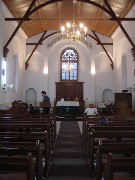 when
they decide no one should cross, it's dangerous. Otherwise, it's
simply an enormous pain in the neck for everyone. (Except for a when
they decide no one should cross, it's dangerous. Otherwise, it's
simply an enormous pain in the neck for everyone. (Except for a 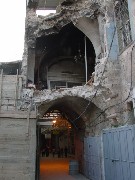 handful
of enterprising villagers, who rent their donkeys out those unable to hike
over the "road's" dusty mounds of rocks.) He finally arrived at the Anglican
Compound, at the edge of Nablus' Old City. When the heated battle
and destruction were taking place in Jenin Camp,
the Old City here was taking a beating. The Anglican Compound lost one
of its old stone walls. Fr. Hossam took Marthame around to see the
damage, which after seeing "Ground Zero" in Jenin, is not nearly as shocking.
But the losses of life here (80) along with the historical nature of the
city (e.g. two thousand-plus year-old soap factories gone), and the overall
destruction (as opposed to the centralized obliteration in Jenin) are enormous
(video - 15 sec.). Most of the damage
was done from the air by F-16s and Apaches, as the ancient streets in the
Old City were too narrow for tanks. Now, in many places the winding
streets you'd usually find are gone, replaced with what resembles a parking
lot. The clean-up has continued (people are in need of getting on
with their lives), but what is missing looms like a gaping cavity.
The caretakers of the Compound, an Orthodox Nablus family, spent the entirety
of the battle and onslaught in their home (and a few days of it in one
room) with a tank parked outside. Most of their windows were broken
from the sound, and a few were broken from stray gunfire. One metal
shutter had an enormous hole blown through it. But they are safe,
and it was good to see them. Fr. Hossam took Marthame to see St.
Philip's Anglican Church (and to sing some Easter hymns - audio
20 sec.), where the city's Anglican community worships once a month.
The other three weeks they worship in Raffidye (now a neighborhood of sprawling
Nablus), but there used to be two thriving communities. It's all
part of the shrinking Christian presence. Word came that Israeli
tanks had entered the city and had headed toward 'Askar Camp, so Fr. Hossam
left for Raffidye. Fortunately, the tanks stayed near the Camp, so
he returned to the Compound for a late night game of pinochle. handful
of enterprising villagers, who rent their donkeys out those unable to hike
over the "road's" dusty mounds of rocks.) He finally arrived at the Anglican
Compound, at the edge of Nablus' Old City. When the heated battle
and destruction were taking place in Jenin Camp,
the Old City here was taking a beating. The Anglican Compound lost one
of its old stone walls. Fr. Hossam took Marthame around to see the
damage, which after seeing "Ground Zero" in Jenin, is not nearly as shocking.
But the losses of life here (80) along with the historical nature of the
city (e.g. two thousand-plus year-old soap factories gone), and the overall
destruction (as opposed to the centralized obliteration in Jenin) are enormous
(video - 15 sec.). Most of the damage
was done from the air by F-16s and Apaches, as the ancient streets in the
Old City were too narrow for tanks. Now, in many places the winding
streets you'd usually find are gone, replaced with what resembles a parking
lot. The clean-up has continued (people are in need of getting on
with their lives), but what is missing looms like a gaping cavity.
The caretakers of the Compound, an Orthodox Nablus family, spent the entirety
of the battle and onslaught in their home (and a few days of it in one
room) with a tank parked outside. Most of their windows were broken
from the sound, and a few were broken from stray gunfire. One metal
shutter had an enormous hole blown through it. But they are safe,
and it was good to see them. Fr. Hossam took Marthame to see St.
Philip's Anglican Church (and to sing some Easter hymns - audio
20 sec.), where the city's Anglican community worships once a month.
The other three weeks they worship in Raffidye (now a neighborhood of sprawling
Nablus), but there used to be two thriving communities. It's all
part of the shrinking Christian presence. Word came that Israeli
tanks had entered the city and had headed toward 'Askar Camp, so Fr. Hossam
left for Raffidye. Fortunately, the tanks stayed near the Camp, so
he returned to the Compound for a late night game of pinochle. |
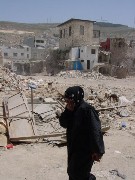 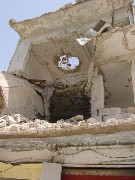 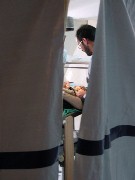 Saturday,
5/11/02: One of our good friends in Nablus is a Dutch nurse who
spent the entire time of the incursion at the Anglican Hospital.
We would get updates from her about the situation in Nablus, since she
has an antiquated "Cellcom" cellphone (Palestinian service was completely
knocked out for weeks). She and Marthame went through the Old City
to see more of the damage - the comment was often how much better things
look now (hard to imagine). People are trying to get on with their
lives, their businesses. Perhaps that's the sign of hope. They
wandered down towards the Jordanian hospital, set up more or less like
a MASH unit, providing free services for the people of Nablus - everything
from a pharmacy to surgery is available. They have been serving about
1700 people each day, something that is clearly needed these days.
It does raise the question of long-term solutions, though, seeing that
there are several hospitals in Nablus upon whom doctors and nurses depend
for their livelihood, and which may have to close their doors from lack
of business. In a crisis like this, temporary emergency help is welcomed,
but we hope it won't come at the cost of the local infrastructure.
The director of the hospital gave Marthame a poster of King Abdallah to
take home. Marthame and our friend then headed Saturday,
5/11/02: One of our good friends in Nablus is a Dutch nurse who
spent the entire time of the incursion at the Anglican Hospital.
We would get updates from her about the situation in Nablus, since she
has an antiquated "Cellcom" cellphone (Palestinian service was completely
knocked out for weeks). She and Marthame went through the Old City
to see more of the damage - the comment was often how much better things
look now (hard to imagine). People are trying to get on with their
lives, their businesses. Perhaps that's the sign of hope. They
wandered down towards the Jordanian hospital, set up more or less like
a MASH unit, providing free services for the people of Nablus - everything
from a pharmacy to surgery is available. They have been serving about
1700 people each day, something that is clearly needed these days.
It does raise the question of long-term solutions, though, seeing that
there are several hospitals in Nablus upon whom doctors and nurses depend
for their livelihood, and which may have to close their doors from lack
of business. In a crisis like this, temporary emergency help is welcomed,
but we hope it won't come at the cost of the local infrastructure.
The director of the hospital gave Marthame a poster of King Abdallah to
take home. Marthame and our friend then headed 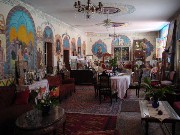 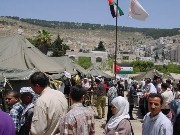 down
to Jacob's Well, the site of Jesus' conversation
with the Samaritan woman about "living water" (John 4). Father Justinus,
the Greek Orthodox priest/caretaker, has been in his position here for
20+ years. He was sent to build a cathedral, and work is progressing
impressively. For the first 16 years, though, it didn't - the Israeli
military government didn't give out many building permits (required to
build new buildings to repair and expand existing ones), so Abuna Justinus
(who is quite the artist) spent them decorating the inside of the convent
with beautiful mosaics and icons. One picture is of one of the previous
caretakers, who was killed in 1979 by a radical rabbi and his followers
who wanted to take the Well over. The work (all by hand) is continuing
- hopefully it will be finished soon. Marthame then headed up with
Fr. Hossam to the Christian neighborhood of Raffidya to have lunch and
to visit with his fiancee, the first time that either of us have seen her
since their engagement in August.
Their wedding will be this summer, so they're busy making plans. (Since
his family is in the Galilee and hers is in Nablus, they are faced with
the problem of location. His family, Israeli citizens, are not allowed
into the West Bank; she and her family are Palestinians not allowed into
Israel. It looks like they will have to foot the expense of getting all
their family to Jordan in order to get down
to Jacob's Well, the site of Jesus' conversation
with the Samaritan woman about "living water" (John 4). Father Justinus,
the Greek Orthodox priest/caretaker, has been in his position here for
20+ years. He was sent to build a cathedral, and work is progressing
impressively. For the first 16 years, though, it didn't - the Israeli
military government didn't give out many building permits (required to
build new buildings to repair and expand existing ones), so Abuna Justinus
(who is quite the artist) spent them decorating the inside of the convent
with beautiful mosaics and icons. One picture is of one of the previous
caretakers, who was killed in 1979 by a radical rabbi and his followers
who wanted to take the Well over. The work (all by hand) is continuing
- hopefully it will be finished soon. Marthame then headed up with
Fr. Hossam to the Christian neighborhood of Raffidya to have lunch and
to visit with his fiancee, the first time that either of us have seen her
since their engagement in August.
Their wedding will be this summer, so they're busy making plans. (Since
his family is in the Galilee and hers is in Nablus, they are faced with
the problem of location. His family, Israeli citizens, are not allowed
into the West Bank; she and her family are Palestinians not allowed into
Israel. It looks like they will have to foot the expense of getting all
their family to Jordan in order to get 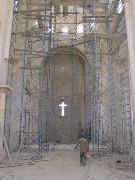 married.)
Marthame then stopped by to see the married.)
Marthame then stopped by to see the 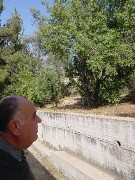 dear
and gentle Abuna Yousef, Melkite priest of St. John the Baptist church.
Unlike his usual manner, though, he was clearly agitated by the situation
- not so much by what had happened in Nablus, but more by the siege of
the Nativity Church. He observed that Sharon made his controversial
visit to Al-Aqsa, to which the whole Muslim world reacted strongly.
Meanwhile, the Church was surrounded by tanks for forty days, eight people
(including a bell-ringer, priest, and a couple of people hanging up laundry)
were shot, seven of them fatally. The response? In his words,
the pope's envoy asked Sharon for permission to visit the Church, was told
no, and accepted this word. His faith in the soldarity of the wider
church with the Christians of this land has waned greatly - but his faith
in Christ is strong. He also shared his plans for a Christian cultural
center and housing complex to be built on the grounds of the Melkite Convent
- something to help stem the tide of Christian emigration. The need
is for funding. We hope he can find it. After visiting with
a friend of ours studying at An-Najah University, and eating Nablus' specialty
dessert of knaffe, Marthame headed back to the Anglican Compound
to join in with the family's nightly ritual of dinner and late night movies
from Jordan (featuring the 1968 Peter Ustinov comedic vehicle Blackbeard's
Ghost - "surreal" only scratches the surface of this place).
The family (a grandmother, her two sons, daughter-in-law, and two grandsons)
shared their stories of what it was like to be here during the military
activity. Sixteen days without leaving home with little (and then
no) water and no electricity. For a stretch of five days, they were
stuck in one room (the only one without windows), unable to stand up beyond
a crawl, as glass shattered in the other rooms and the constant sound of
tank and machine gunfire echoed, punctuated by the periodic horrific rush
of an F-16 bomb. This is the frustration Palestinians share in common
- many people, regardless of political or military involvement, suffer
similarly. the "terrorist infrastructure". Hard to imagine.
One of the sons spent most of those five days entertaining the two grandsons,
doing shadow puppets on the wall. At one point, they devised a shirt
for use at checkpoints - by tying strings from the sleeves to the bottom
of the shirt, you could raise your arms and your shirt in one movement
(something many young Palestinian men have been forced to do in the last
several months). They jokingly made plans to market their new invention.
Such is humor these days... dear
and gentle Abuna Yousef, Melkite priest of St. John the Baptist church.
Unlike his usual manner, though, he was clearly agitated by the situation
- not so much by what had happened in Nablus, but more by the siege of
the Nativity Church. He observed that Sharon made his controversial
visit to Al-Aqsa, to which the whole Muslim world reacted strongly.
Meanwhile, the Church was surrounded by tanks for forty days, eight people
(including a bell-ringer, priest, and a couple of people hanging up laundry)
were shot, seven of them fatally. The response? In his words,
the pope's envoy asked Sharon for permission to visit the Church, was told
no, and accepted this word. His faith in the soldarity of the wider
church with the Christians of this land has waned greatly - but his faith
in Christ is strong. He also shared his plans for a Christian cultural
center and housing complex to be built on the grounds of the Melkite Convent
- something to help stem the tide of Christian emigration. The need
is for funding. We hope he can find it. After visiting with
a friend of ours studying at An-Najah University, and eating Nablus' specialty
dessert of knaffe, Marthame headed back to the Anglican Compound
to join in with the family's nightly ritual of dinner and late night movies
from Jordan (featuring the 1968 Peter Ustinov comedic vehicle Blackbeard's
Ghost - "surreal" only scratches the surface of this place).
The family (a grandmother, her two sons, daughter-in-law, and two grandsons)
shared their stories of what it was like to be here during the military
activity. Sixteen days without leaving home with little (and then
no) water and no electricity. For a stretch of five days, they were
stuck in one room (the only one without windows), unable to stand up beyond
a crawl, as glass shattered in the other rooms and the constant sound of
tank and machine gunfire echoed, punctuated by the periodic horrific rush
of an F-16 bomb. This is the frustration Palestinians share in common
- many people, regardless of political or military involvement, suffer
similarly. the "terrorist infrastructure". Hard to imagine.
One of the sons spent most of those five days entertaining the two grandsons,
doing shadow puppets on the wall. At one point, they devised a shirt
for use at checkpoints - by tying strings from the sleeves to the bottom
of the shirt, you could raise your arms and your shirt in one movement
(something many young Palestinian men have been forced to do in the last
several months). They jokingly made plans to market their new invention.
Such is humor these days... |
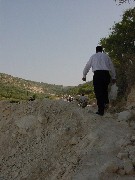 Sunday,
5/12/02: Marthame and Fr. Hossam left early for Zababdeh, leaving
Nablus back for the village of Zawata, making the long trek back up the
hill, across the military road, for the waiting taxis. The number
of people filing into Nablus (the morning commute) was staggering - people
dressed in their business best, struggling downhill, making their way between
the donkeys bearing people or their bags, through the white dust, coming
out on the other side coated with a thin layer of the stuff. Last
week, as Fr. Hossam returned to Nablus for Easter prayers, soldiers appeared
on the military road. Three times the people commuting into town
were forced to retreat back up the hill in what seemed like a twisted game
of cat and mouse. After a late night, an early morning, an empty
stomach, a steep climb, and a winding road, Marthame needed to stop along
the road a couple of times for - uh - personal moments. Needless
to say, he didn't join Fr. Hossam as planned for morning worship, but spent
the rest of the day recovering under Elizabeth's watchful eye. What's
incredible is that Fr. Hossam makes this journey every week - twice! Sunday,
5/12/02: Marthame and Fr. Hossam left early for Zababdeh, leaving
Nablus back for the village of Zawata, making the long trek back up the
hill, across the military road, for the waiting taxis. The number
of people filing into Nablus (the morning commute) was staggering - people
dressed in their business best, struggling downhill, making their way between
the donkeys bearing people or their bags, through the white dust, coming
out on the other side coated with a thin layer of the stuff. Last
week, as Fr. Hossam returned to Nablus for Easter prayers, soldiers appeared
on the military road. Three times the people commuting into town
were forced to retreat back up the hill in what seemed like a twisted game
of cat and mouse. After a late night, an early morning, an empty
stomach, a steep climb, and a winding road, Marthame needed to stop along
the road a couple of times for - uh - personal moments. Needless
to say, he didn't join Fr. Hossam as planned for morning worship, but spent
the rest of the day recovering under Elizabeth's watchful eye. What's
incredible is that Fr. Hossam makes this journey every week - twice! |
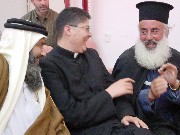 Monday,
5/13/02: Marthame was planning to head up to Jenin to take care
of some errands while Elizabeth continued with Monday,
5/13/02: Marthame was planning to head up to Jenin to take care
of some errands while Elizabeth continued with 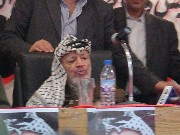 her
daily class - the pared back schedule has meant that she is no longer
teaching the 11th graders, nor the 1st through 4th graders. While
she misses most of them, the extra time (especially as we wrap things up
and put together our summer travel itinerary) is quite welcome. Today
was Arafat's first day out of Ramallah in months, and he was planning to
visit Bethlehem, Jenin, and Nablus in a borrowed Jordanian helicopter.
Marthame, Abuna Aktham, Abuna To'mie, the Sheikh, and the village mayor
headed up to the Jenin governate for the reception. Representatives
of most of the surrounding villages were there, and we could see the Christian
community well-represented from Jenin and Burqin
as well. When Arafat arrived, he was followed by a group of clapping
and shouting and chanting
shabbab (young men). In some ways
it was reminiscent of Saddam Hussein's staged rallies, but for the most
part it felt quite genuine. The soldiers and police, many of them
now unarmed, had a difficult time controlling the crowds, and our view
was soon blocked by her
daily class - the pared back schedule has meant that she is no longer
teaching the 11th graders, nor the 1st through 4th graders. While
she misses most of them, the extra time (especially as we wrap things up
and put together our summer travel itinerary) is quite welcome. Today
was Arafat's first day out of Ramallah in months, and he was planning to
visit Bethlehem, Jenin, and Nablus in a borrowed Jordanian helicopter.
Marthame, Abuna Aktham, Abuna To'mie, the Sheikh, and the village mayor
headed up to the Jenin governate for the reception. Representatives
of most of the surrounding villages were there, and we could see the Christian
community well-represented from Jenin and Burqin
as well. When Arafat arrived, he was followed by a group of clapping
and shouting and chanting
shabbab (young men). In some ways
it was reminiscent of Saddam Hussein's staged rallies, but for the most
part it felt quite genuine. The soldiers and police, many of them
now unarmed, had a difficult time controlling the crowds, and our view
was soon blocked by 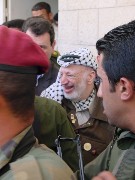 a
swirling, shoving mob (video - 5 sec.)
- not unlike the scene at the Church of the Holy Sepulchre we encountered
a few weeks ago. Two observations mingled, one being that Arafat
still commands great celebrity, if not adoration from his people - such
was the rush to greet him and shake his hand. The other is that his
security forces can't even do crowd control - how can they clamp down on
"terror"? He left in a rush, barely stopping at Jenin Camp, which
brought him strong criticism. His popularity, which surged when he
was locked down in Ramallah, is on uncertain footing. As we visited
with friends this evening, we could hear a tank on the move near the military
camp. We never expected that we'd be so familiarized with its sound
- nor that
dababe (tank) would be one of the first words children
learn. We also got a chance to visit with one of our dear friends
from the long-neglected Melkite (Greek Catholic) community of Zababdeh.
He's hopefully on his way towards ordination, working with the Bishop of
Haifa. His story of traveling in Israel the other day (even with
proper permissions) was harrowing - two unmarked cars stopped his taxi,
not long after he walked across the Jalame checkpoint, and pulled their
weapons as they threw the doors open and demanded IDs. "They were
very nervous," he said about the policemen. We hope the ordination
process is worth the trouble. a
swirling, shoving mob (video - 5 sec.)
- not unlike the scene at the Church of the Holy Sepulchre we encountered
a few weeks ago. Two observations mingled, one being that Arafat
still commands great celebrity, if not adoration from his people - such
was the rush to greet him and shake his hand. The other is that his
security forces can't even do crowd control - how can they clamp down on
"terror"? He left in a rush, barely stopping at Jenin Camp, which
brought him strong criticism. His popularity, which surged when he
was locked down in Ramallah, is on uncertain footing. As we visited
with friends this evening, we could hear a tank on the move near the military
camp. We never expected that we'd be so familiarized with its sound
- nor that
dababe (tank) would be one of the first words children
learn. We also got a chance to visit with one of our dear friends
from the long-neglected Melkite (Greek Catholic) community of Zababdeh.
He's hopefully on his way towards ordination, working with the Bishop of
Haifa. His story of traveling in Israel the other day (even with
proper permissions) was harrowing - two unmarked cars stopped his taxi,
not long after he walked across the Jalame checkpoint, and pulled their
weapons as they threw the doors open and demanded IDs. "They were
very nervous," he said about the policemen. We hope the ordination
process is worth the trouble. |
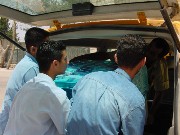 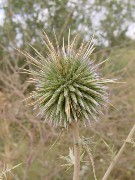 Tuesday,
5/14/02: The biggest news to reach the school today was the new
copy machine. It was ordered several months ago, but only now has
the road been re-opened enough to transport it here. Elizabeth found
time to go for a walk with a friend from the University. It was very nice
to get out into the fields and hills again, seeing up close the local nature
after a long absence. It's clear spring has ended and summer arrived, as
the wheatfields and grasses in the hills yellow the landscape, which is
still spotted with green olive trees and fields of cabbage and zucchini.
Thistles are in full swing: blueish, purple, yellow, white all going gangbusters.
Meanwhile, Marthame visited with our Melkite friend, learning some of the
prayers from their Byzantine Mass - both for self-edification and to share
some in worship during our summer itineration. Tuesday,
5/14/02: The biggest news to reach the school today was the new
copy machine. It was ordered several months ago, but only now has
the road been re-opened enough to transport it here. Elizabeth found
time to go for a walk with a friend from the University. It was very nice
to get out into the fields and hills again, seeing up close the local nature
after a long absence. It's clear spring has ended and summer arrived, as
the wheatfields and grasses in the hills yellow the landscape, which is
still spotted with green olive trees and fields of cabbage and zucchini.
Thistles are in full swing: blueish, purple, yellow, white all going gangbusters.
Meanwhile, Marthame visited with our Melkite friend, learning some of the
prayers from their Byzantine Mass - both for self-edification and to share
some in worship during our summer itineration. |
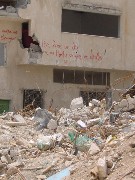 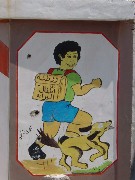 Wednesday,
5/15/02: Today is the day Palestinians mark Al-Nakbe (the
Catastrophe), the founding of the State of Israelwhich led to their subsequent
exile and/or humiliation. Rallies and speeches were planned.
Along with Israeli incursions last night into four different places in
the West Bank, we were anxious - not for ourselves, but for the fact that
we expected visitors today. A few ex-pat friends of ours living in the
Galilee came this morning. The plan was for them to come to the Jalame
checkpoint where we would meet them in a taxi to take them back to Zababdeh
for quick look around before heading off to Jenin Camp so they could see
the scene "with their own eyes". They arrived a little after 9:00.
They arrived in Zababdeh a little after 10:00 (taking the circuitous tractor
roads - two of our guests, who spent six years in Kenya, said they felt
more at home in the West Bank than in Israel), visited Abuna Aktham at
the Latin School, then headed off to Jenin Camp, arriving around 11:00.
A trip that would've taken fifteen minutes a few months ago (from Jalame
to Jenin) now takes closer to two hours. Marthame went with them
along with our friend from the Melkite community. It was the first
time either of us had been since we went with students from the Arab-American
University of Jenin. Someone has been adding to the graffiti on the
ruins, adding slogans like "Live Free or Die", "Give me librty [sic] or
give me death," or "We won't forgive, we won't forget" (reminiscent of
Elie Wiesel's sentiment). They didn't have long, but were able to
get a sense of the breadth of destruction. What's most striking is
how much more work is still to be Wednesday,
5/15/02: Today is the day Palestinians mark Al-Nakbe (the
Catastrophe), the founding of the State of Israelwhich led to their subsequent
exile and/or humiliation. Rallies and speeches were planned.
Along with Israeli incursions last night into four different places in
the West Bank, we were anxious - not for ourselves, but for the fact that
we expected visitors today. A few ex-pat friends of ours living in the
Galilee came this morning. The plan was for them to come to the Jalame
checkpoint where we would meet them in a taxi to take them back to Zababdeh
for quick look around before heading off to Jenin Camp so they could see
the scene "with their own eyes". They arrived a little after 9:00.
They arrived in Zababdeh a little after 10:00 (taking the circuitous tractor
roads - two of our guests, who spent six years in Kenya, said they felt
more at home in the West Bank than in Israel), visited Abuna Aktham at
the Latin School, then headed off to Jenin Camp, arriving around 11:00.
A trip that would've taken fifteen minutes a few months ago (from Jalame
to Jenin) now takes closer to two hours. Marthame went with them
along with our friend from the Melkite community. It was the first
time either of us had been since we went with students from the Arab-American
University of Jenin. Someone has been adding to the graffiti on the
ruins, adding slogans like "Live Free or Die", "Give me librty [sic] or
give me death," or "We won't forgive, we won't forget" (reminiscent of
Elie Wiesel's sentiment). They didn't have long, but were able to
get a sense of the breadth of destruction. What's most striking is
how much more work is still to be 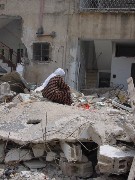 done
- a couple of dump trucks and a bulldozer or two were active, but the destruction
remains pretty overwhelming. People whose houses were destroyed are
coming back during the day from wherever they're sleeping to sift and dig
a little and to just stare at it all - or so it seemed to us. Our
friends headed back to the Galilee, having spent most of the day in the
car, but having seen a bit of what's here - they promised to return.
Another friend was planning to come from Jerusalem, as he had done a few
months back - last time he was turned back at the Hamra checkpoint.
This time, believe it or not, he actually made it - they were turned back
from one checkpoint, but made it through another one. We were able
to take him around to visit some friends and to see the village.
He'll stay with us a few days - at least, that's the plan. We're
also hosting one of the University's professors who has returned here for
a week to help get the Business School up and running. Just a long
day of playing host - something we haven't gotten to do much of since we've
been here, but something we thoroughly enjoy. Tomorrow will bring
more of that, n'sha'allah, as another group is hoping to come on
a Christian solidarity visit to Zababdeh. We hope that they arrive
without event, as our guests arrived today. done
- a couple of dump trucks and a bulldozer or two were active, but the destruction
remains pretty overwhelming. People whose houses were destroyed are
coming back during the day from wherever they're sleeping to sift and dig
a little and to just stare at it all - or so it seemed to us. Our
friends headed back to the Galilee, having spent most of the day in the
car, but having seen a bit of what's here - they promised to return.
Another friend was planning to come from Jerusalem, as he had done a few
months back - last time he was turned back at the Hamra checkpoint.
This time, believe it or not, he actually made it - they were turned back
from one checkpoint, but made it through another one. We were able
to take him around to visit some friends and to see the village.
He'll stay with us a few days - at least, that's the plan. We're
also hosting one of the University's professors who has returned here for
a week to help get the Business School up and running. Just a long
day of playing host - something we haven't gotten to do much of since we've
been here, but something we thoroughly enjoy. Tomorrow will bring
more of that, n'sha'allah, as another group is hoping to come on
a Christian solidarity visit to Zababdeh. We hope that they arrive
without event, as our guests arrived today. |
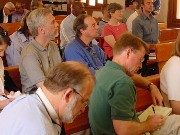 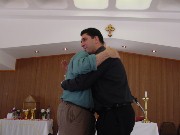 Thursday,
5/16/02: When we lived in Chicago, we had a phrase to signify
small moments of grace - "the God of the parking meter" - things that aren't
earth-shattering, but are wonderful, helpful small occurrences - a sign
of God's omnipotence and omnipresence. Today, "the God of the checkpoint"
was at work. Thursday,
5/16/02: When we lived in Chicago, we had a phrase to signify
small moments of grace - "the God of the parking meter" - things that aren't
earth-shattering, but are wonderful, helpful small occurrences - a sign
of God's omnipotence and omnipresence. Today, "the God of the checkpoint"
was at work. 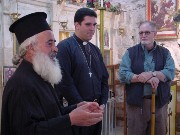 We
left Zababdeh in Abuna Aktham's car, heading down to the Tayasir checkpoint
to meet the Sabeel group who were coming to visit us. They had arrived
a minute or two before us, and the group leader needed to do very little
negotiating. The bus, with yellow (Israeli) plates and Jerusalemite
driver, entered almost immediately. The group of twenty-five American
Christians, mostly Episcopalian including two bishops (Washington and Massachusetts),
headed up with us to Zababdeh. Fr. Hossam was able to make it up
from Nablus early in the morning and took them around the town. Our
visitor from Jerusalem joined in with the group. First stop was St.
Matthew's Anglican We
left Zababdeh in Abuna Aktham's car, heading down to the Tayasir checkpoint
to meet the Sabeel group who were coming to visit us. They had arrived
a minute or two before us, and the group leader needed to do very little
negotiating. The bus, with yellow (Israeli) plates and Jerusalemite
driver, entered almost immediately. The group of twenty-five American
Christians, mostly Episcopalian including two bishops (Washington and Massachusetts),
headed up with us to Zababdeh. Fr. Hossam was able to make it up
from Nablus early in the morning and took them around the town. Our
visitor from Jerusalem joined in with the group. First stop was St.
Matthew's Anglican 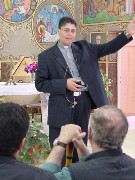 Church,
where we shared a bit of fellowship and greetings - including those from
Zababdeh's sister church in the Diocese of Olympia, WA - before singing
together "How Great Thou Art" in Arabic and English (audio
- 13 sec.). We visited the Pennman Clinic, one of the outreach ministries
of the Anglican church, before heading off to visit Abuna Tom'ie at St.
George's Orthodox Church. He spoke of the history of the Greek Orthodox
Church and of Zababdeh's churches at the "forgotten church" before Church,
where we shared a bit of fellowship and greetings - including those from
Zababdeh's sister church in the Diocese of Olympia, WA - before singing
together "How Great Thou Art" in Arabic and English (audio
- 13 sec.). We visited the Pennman Clinic, one of the outreach ministries
of the Anglican church, before heading off to visit Abuna Tom'ie at St.
George's Orthodox Church. He spoke of the history of the Greek Orthodox
Church and of Zababdeh's churches at the "forgotten church" before 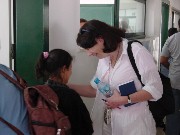 singing
"Al-Masiih
Qam" (Christ is Risen), a traditional Byantine hymn (audio
- 21 sec.), and leading us in prayers. Meanwhile, Elizabeth had to slip
off to teach her last class of the school year. It was a nostalgic
moment for her as this group of 20 seventh-graders was her first real class
(i.e. kids for whom she was the only English teacher and whom she saw every
day). The kids were very sad to hear theat it was her last day with them,
but a little happy to get the chocolate candy she brought them. Elizabeth
will miss these kids a lot. As her class let out, the group was arriving
at the school, guided through the halls by Abuna Aktham. This is the first
group that has come to visit Zababdeh in a year
(apart from the random individual or group of three or four people), and
the kids were in full-chaos mode, standing on their desks to wave to the
visitors, shaking hands with whomever would stop to do so (which they all
did). It was a real treat, topped off by a quick stop in the Kindergarten
where the children are getting ready for tomorrow's graduation - cute factor
10+. We shared a traditional Palestinian meal in the Anglican church
hall before boarding the bus for Jenin Camp. We were able to connect
with some young men from Jenin who know the story of the Camp quite well
and were glad to bring visitors there. singing
"Al-Masiih
Qam" (Christ is Risen), a traditional Byantine hymn (audio
- 21 sec.), and leading us in prayers. Meanwhile, Elizabeth had to slip
off to teach her last class of the school year. It was a nostalgic
moment for her as this group of 20 seventh-graders was her first real class
(i.e. kids for whom she was the only English teacher and whom she saw every
day). The kids were very sad to hear theat it was her last day with them,
but a little happy to get the chocolate candy she brought them. Elizabeth
will miss these kids a lot. As her class let out, the group was arriving
at the school, guided through the halls by Abuna Aktham. This is the first
group that has come to visit Zababdeh in a year
(apart from the random individual or group of three or four people), and
the kids were in full-chaos mode, standing on their desks to wave to the
visitors, shaking hands with whomever would stop to do so (which they all
did). It was a real treat, topped off by a quick stop in the Kindergarten
where the children are getting ready for tomorrow's graduation - cute factor
10+. We shared a traditional Palestinian meal in the Anglican church
hall before boarding the bus for Jenin Camp. We were able to connect
with some young men from Jenin who know the story of the Camp quite well
and were glad to bring visitors there. 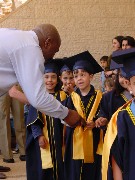 The
group was clearly stunned by what they saw, as most people are. Some
commented that they were sickened - an appropriate reaction when you're
talking to people who are pointing to where their homes used to be and
telling tales of the fear. More than one person broke down in tears
as they talk about the affect on their children, their spouses, themselves.
We parted company with them, promising to see some of them in Boston and
Maine this summer, sending them off to Nazareth as we headed back to The
group was clearly stunned by what they saw, as most people are. Some
commented that they were sickened - an appropriate reaction when you're
talking to people who are pointing to where their homes used to be and
telling tales of the fear. More than one person broke down in tears
as they talk about the affect on their children, their spouses, themselves.
We parted company with them, promising to see some of them in Boston and
Maine this summer, sending them off to Nazareth as we headed back to 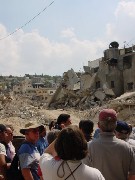 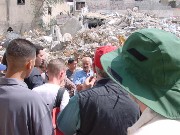 Zababdeh.
It was a long, exhausting day, but wonderful - the schedule gelled well,
the group was enthusiastic and pleased, and it was a long-overdue chance
to show of the area of Zababdeh that we've come to know and love.
There is so much more to see, including the Christian communities in Tubas,
Jenin,
and Burqin, not to mention the Arab-American
University of Jenin, but for six hours, we saw quite a bit. We look
forward to doing it again soon. On the road back, we got a call that
we should be careful - tanks were parked on the road between Misilye and
Zababdeh. The traffic coming the other way gave us the same warnings.
Sure enough, we could see the path two tanks had carved through what used
to be someone's field of
hummous, one of them pointing their barrel
directly at the on-coming traffic (that is, us). That's the absurdity
of this place - we were having some banal conversation, stared down the
tank barrel, and then returned to our banal conversation as if passing
a tank barrel were just simply a normal daily occurrence. Marthame
and our friend headed up to the University's coffee shop to visit with
friends of his who had come up from Jerusalem. The conversation was
fascinating as we left behind the controversy and emotion of political
conversations for that of religion - those who see Islam as a monolithic
faith would be lucky - as we have been - to have such encounters and see
the variety of opinion and practice in the Muslim world. When we
were all back home, we could hear the sound of a tank shell being fired
in the distance - again, a banal conversation was interrupted only to be
continued immediately. Heek hayatna ("that's our life" - the
Arabic equivalent of c'est la vie). Zababdeh.
It was a long, exhausting day, but wonderful - the schedule gelled well,
the group was enthusiastic and pleased, and it was a long-overdue chance
to show of the area of Zababdeh that we've come to know and love.
There is so much more to see, including the Christian communities in Tubas,
Jenin,
and Burqin, not to mention the Arab-American
University of Jenin, but for six hours, we saw quite a bit. We look
forward to doing it again soon. On the road back, we got a call that
we should be careful - tanks were parked on the road between Misilye and
Zababdeh. The traffic coming the other way gave us the same warnings.
Sure enough, we could see the path two tanks had carved through what used
to be someone's field of
hummous, one of them pointing their barrel
directly at the on-coming traffic (that is, us). That's the absurdity
of this place - we were having some banal conversation, stared down the
tank barrel, and then returned to our banal conversation as if passing
a tank barrel were just simply a normal daily occurrence. Marthame
and our friend headed up to the University's coffee shop to visit with
friends of his who had come up from Jerusalem. The conversation was
fascinating as we left behind the controversy and emotion of political
conversations for that of religion - those who see Islam as a monolithic
faith would be lucky - as we have been - to have such encounters and see
the variety of opinion and practice in the Muslim world. When we
were all back home, we could hear the sound of a tank shell being fired
in the distance - again, a banal conversation was interrupted only to be
continued immediately. Heek hayatna ("that's our life" - the
Arabic equivalent of c'est la vie). |
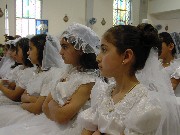 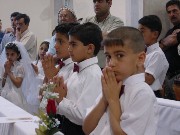 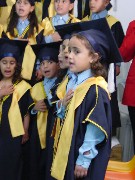 Friday,
5/17/02: We headed of to the Latin church for worship this morning.
Today is first communion, and the Rosary Sisters have been preparing the
third graders for weeks now. Abuna Ra'ed, who works in the Latin
Patriarchate and is a Zababdeh native, was there, as were three Italian
priests on a visit collecting information for Pax
Christi. The Bishop of Nazareth, Boulos Marcuzzo, was making
his way here, but was turned back at the Jalame checkpoint. This
morning at 4:00, fifteen tanks entered Jenin - that may explain the tanks
near Zababdeh last night. He headed down to the Tayasir checkpoint
where, though he was the first car in line (with consular plates and Latin
Patriarchate flags to boot), he was made to wait for forty-five minutes
before the soldiers bothered to come to his car. He arrived a bit
late, but in plenty of time for the first Communion. First communion
struck a familiar chord with youth Sundays - the children who had been
prepped were also responsible for the lay leadership of the Mass - Scripture
readings, prayer requests, etc. Immediately after the Mass, the crowds
shifted down to the Church Hall for cute-factor #2, Kindgarten Graduation
(video - 11 sec.). Before the adorable
little ones received their adorable little diplomas, there were a few speeches,
presentations, and songs (audio - 14 sec.).
One of them is a new Friday,
5/17/02: We headed of to the Latin church for worship this morning.
Today is first communion, and the Rosary Sisters have been preparing the
third graders for weeks now. Abuna Ra'ed, who works in the Latin
Patriarchate and is a Zababdeh native, was there, as were three Italian
priests on a visit collecting information for Pax
Christi. The Bishop of Nazareth, Boulos Marcuzzo, was making
his way here, but was turned back at the Jalame checkpoint. This
morning at 4:00, fifteen tanks entered Jenin - that may explain the tanks
near Zababdeh last night. He headed down to the Tayasir checkpoint
where, though he was the first car in line (with consular plates and Latin
Patriarchate flags to boot), he was made to wait for forty-five minutes
before the soldiers bothered to come to his car. He arrived a bit
late, but in plenty of time for the first Communion. First communion
struck a familiar chord with youth Sundays - the children who had been
prepped were also responsible for the lay leadership of the Mass - Scripture
readings, prayer requests, etc. Immediately after the Mass, the crowds
shifted down to the Church Hall for cute-factor #2, Kindgarten Graduation
(video - 11 sec.). Before the adorable
little ones received their adorable little diplomas, there were a few speeches,
presentations, and songs (audio - 14 sec.).
One of them is a new 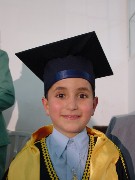 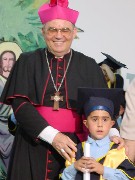 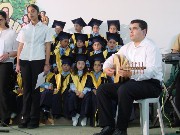 Lebanese
song which has become quite popular, "Nahnu mish irhabi", with the
chorus, "We're not terrorists. We're the people of freedom - Muslims
and Christians." Everywhere you go in the West Bank, people are singing
this - Muslims and Christians. Unfortunately, some folks - including the
head kindergarten teacher - weren't able to come because of the new Jenin
incursion. We simply hope they'll be able to continue with school.
We shared lunch with Bishop Marcuzzo and the other guests before getting
a ride up to Nazareth in his car. Our wait at the checkpoint was
much shorter, but as each car approached, one soldier's job was to aim
his gun at the driver, who must leave the car and approach the other soldier.
Yipe. Bishop Marcuzzo has been in the Middle East for forty years,
leaving Italy to study at the Latin Seminary in Beit Jala. Before
becoming Bishop in 1994, he spent six years (in the 70s) serving a Christian
tribe along the Nile in the southern Sudan, where he learned a great deal
about the traditional tribal religions and how they interact with Christianity.
We shared ice cream and coffee at the Bishopric, along with the Italian
visitors, before heading off to our friends to catch our breath.
Tomorrow, we head off to Jordan and then to the Evangelicals
for Middle East Understanding conference, so this is a short breath-catcher.
Nonetheless, it is a relief to be out of Jenin for a while. Lebanese
song which has become quite popular, "Nahnu mish irhabi", with the
chorus, "We're not terrorists. We're the people of freedom - Muslims
and Christians." Everywhere you go in the West Bank, people are singing
this - Muslims and Christians. Unfortunately, some folks - including the
head kindergarten teacher - weren't able to come because of the new Jenin
incursion. We simply hope they'll be able to continue with school.
We shared lunch with Bishop Marcuzzo and the other guests before getting
a ride up to Nazareth in his car. Our wait at the checkpoint was
much shorter, but as each car approached, one soldier's job was to aim
his gun at the driver, who must leave the car and approach the other soldier.
Yipe. Bishop Marcuzzo has been in the Middle East for forty years,
leaving Italy to study at the Latin Seminary in Beit Jala. Before
becoming Bishop in 1994, he spent six years (in the 70s) serving a Christian
tribe along the Nile in the southern Sudan, where he learned a great deal
about the traditional tribal religions and how they interact with Christianity.
We shared ice cream and coffee at the Bishopric, along with the Italian
visitors, before heading off to our friends to catch our breath.
Tomorrow, we head off to Jordan and then to the Evangelicals
for Middle East Understanding conference, so this is a short breath-catcher.
Nonetheless, it is a relief to be out of Jenin for a while. |
|
Saturday, 5/18/02: The commute from Nazareth to Amman to Beirut was simple - if a bit roundabout. Lebanon is just north of Israel, and really not that far from the northern West Bank but there is no border crossing between the two countries (unless you happen to be a UN peace-keeper). We left Israel through the northern Beisan/Sheikh Hussein border crossing, sharing a taxi down to Amman with an Israeli Arab from the Galilee. There are many new checkpoints along the road, a sign of a nervous Jordanian government, trying to prevent arms or aggression crossing its borders to either of its western neighbors. After visiting with some friends from the Zababdeh 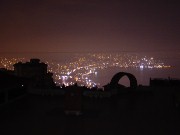 diaspora
in Amman, we headed off to Beirut. Traveling in the Middle East usually
requires two passports - one to "taint" with Israeli stamps, one to "taint"
with countries who have not signed treaties with Israel (Lebanon and Syria
being among them). We were nervous arriving in Lebanon that they
would wonder about our two year passport (usually a sign that we're doing
the passport shuffle), but being part of a group invited by the Middle
East Council of Churches meant no worries. We headed through
the neon Beirut night towards our accomodations north of (and above) town
in formerly-sleepy Jounieh. During the war, many people moved out of the
crossfire up the mountain into Jouneih, which has become a popular classy
night-spot, perhaps due to its proximity to the famed Casino de Liban.
The first thing you notice about Beirut after living in the Middle East
for a while is the billboards - which seem very Western, with plenty of
barely-clad shapely ladies showing their goods. Everything from cellulite-removal
to chewing gum uses skin to sell. Very unlike the West Bank - or
anywhere else we've been over here. As strikingly Western as Israel is,
even Tel Aviv doesn't rival Beirut for bearing flesh (on billboards, TV,
at the cafe, or on the beach). We arrived at the Conference Center at the
Monastery of Our Lady of the Mountain in Jounieh, a spectacular mountain
drive. Our room overlooks the bright lights of Beirut along the Mediterranean
coast. It's a long way from Zababdeh. diaspora
in Amman, we headed off to Beirut. Traveling in the Middle East usually
requires two passports - one to "taint" with Israeli stamps, one to "taint"
with countries who have not signed treaties with Israel (Lebanon and Syria
being among them). We were nervous arriving in Lebanon that they
would wonder about our two year passport (usually a sign that we're doing
the passport shuffle), but being part of a group invited by the Middle
East Council of Churches meant no worries. We headed through
the neon Beirut night towards our accomodations north of (and above) town
in formerly-sleepy Jounieh. During the war, many people moved out of the
crossfire up the mountain into Jouneih, which has become a popular classy
night-spot, perhaps due to its proximity to the famed Casino de Liban.
The first thing you notice about Beirut after living in the Middle East
for a while is the billboards - which seem very Western, with plenty of
barely-clad shapely ladies showing their goods. Everything from cellulite-removal
to chewing gum uses skin to sell. Very unlike the West Bank - or
anywhere else we've been over here. As strikingly Western as Israel is,
even Tel Aviv doesn't rival Beirut for bearing flesh (on billboards, TV,
at the cafe, or on the beach). We arrived at the Conference Center at the
Monastery of Our Lady of the Mountain in Jounieh, a spectacular mountain
drive. Our room overlooks the bright lights of Beirut along the Mediterranean
coast. It's a long way from Zababdeh. |
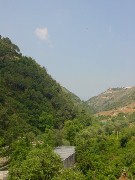 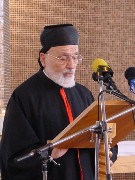 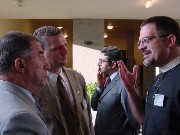 Sunday,
5/19/02: As the last conference participants arrived throughout
the morning, we headed out to the caves of Jeita. Snuggled in among
Lebanon's many rolling hills, these caves sport imposing stalagtites and
stalagmites, delicate curtain formations and many other patterns built
by the patient work of water over millenia. Unfortunately, photography
is forbidden, so what we saw will have to be preserved in our minds (and
a handful of postcards). From everything that we've heard about the
beauty of Lebanon, this may simply be the beginning of a week of awe.
We returned to greet newly-arrived conferees, coming from Iraq and the
States and everywhere in between. We began, as we rightly should,
with worship (audio - 11 sec.) - the Maronites,
Syrians, Latins, Protestants, Armenians, all were represented and participated.
Lebanese TV is covering the entire conference - not unusual coverage for
a country that is half-Christian. We shared in fellowship and food
(always a necessity) before being formally welcomed by both the Middle
East Council of Churches and Evangelicals
for Middle East Understanding. The hope for this meeting is to
be the people of the incarnation, living a message of solidarity for the
Church - not only here in the land of its birth, but throughout the world.
There is deep appreciation for us Westerners simply being here, especially
at a time when most people think we're nuts for coming to countries our
nation considers pariahs. Sunday,
5/19/02: As the last conference participants arrived throughout
the morning, we headed out to the caves of Jeita. Snuggled in among
Lebanon's many rolling hills, these caves sport imposing stalagtites and
stalagmites, delicate curtain formations and many other patterns built
by the patient work of water over millenia. Unfortunately, photography
is forbidden, so what we saw will have to be preserved in our minds (and
a handful of postcards). From everything that we've heard about the
beauty of Lebanon, this may simply be the beginning of a week of awe.
We returned to greet newly-arrived conferees, coming from Iraq and the
States and everywhere in between. We began, as we rightly should,
with worship (audio - 11 sec.) - the Maronites,
Syrians, Latins, Protestants, Armenians, all were represented and participated.
Lebanese TV is covering the entire conference - not unusual coverage for
a country that is half-Christian. We shared in fellowship and food
(always a necessity) before being formally welcomed by both the Middle
East Council of Churches and Evangelicals
for Middle East Understanding. The hope for this meeting is to
be the people of the incarnation, living a message of solidarity for the
Church - not only here in the land of its birth, but throughout the world.
There is deep appreciation for us Westerners simply being here, especially
at a time when most people think we're nuts for coming to countries our
nation considers pariahs. |
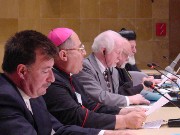 Monday,
5/20/02: The conference continued full speed today - the days
are very, very full. It began with a Bible study focusing on hope,
led by an Egyptian Presbyterian pastor. The Armenian Catholicos of
Cilicia (the names of the church hierarchy are wonderful) spoke about hope,
sharing his thought that, "in a society where certain kinds of sicknesses
are dominant, the Monday,
5/20/02: The conference continued full speed today - the days
are very, very full. It began with a Bible study focusing on hope,
led by an Egyptian Presbyterian pastor. The Armenian Catholicos of
Cilicia (the names of the church hierarchy are wonderful) spoke about hope,
sharing his thought that, "in a society where certain kinds of sicknesses
are dominant, the 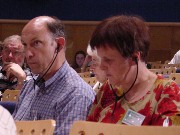 church
needs to bring healing." There is quite an Armenian diaspora in the
Middle East. As the first Christianized nation, Armenia has sent pilgrims
and emigrants to Jerusalem for well over a thousand years. In Iran, Armenian
communities have been known for their quality craftsmanship since the days
of ancient Persia. From there, they spread west to Iraq and beyond.
The Armenian genocides, which climaxed in 1915, claimed the lives of one
and a half million Armenians, out of a total of two and a half million
Armenians in the Ottoman Empire. Those who could escape the Young Turks'
policy of murder and "relocation" fled over the borders, swelling Armenian
communities already in Arab lands. We also heard from Coptic and Greek
Orthodox church leaders, sharing their visions as well as their challenges
to us as Western Christians. There were also several panels, including
one on church partnership, and another on equipping the church. The
centerpiece was the panel of Iraqi church leaders from the Armenian, Syrian,
Chaldean, and Evangelical (Presbyterian) churches. It was a real
treat to have them attending the Conference and enriching our gathering.
We were especially excited to see a few familiar faces, of people we had
the privilege to meet last year during the 5th
Christian Conference in Iraq: "The Church Serving Peace and Humanity."
The words from our Iraqi brothers and sisters - then and now - were clear church
needs to bring healing." There is quite an Armenian diaspora in the
Middle East. As the first Christianized nation, Armenia has sent pilgrims
and emigrants to Jerusalem for well over a thousand years. In Iran, Armenian
communities have been known for their quality craftsmanship since the days
of ancient Persia. From there, they spread west to Iraq and beyond.
The Armenian genocides, which climaxed in 1915, claimed the lives of one
and a half million Armenians, out of a total of two and a half million
Armenians in the Ottoman Empire. Those who could escape the Young Turks'
policy of murder and "relocation" fled over the borders, swelling Armenian
communities already in Arab lands. We also heard from Coptic and Greek
Orthodox church leaders, sharing their visions as well as their challenges
to us as Western Christians. There were also several panels, including
one on church partnership, and another on equipping the church. The
centerpiece was the panel of Iraqi church leaders from the Armenian, Syrian,
Chaldean, and Evangelical (Presbyterian) churches. It was a real
treat to have them attending the Conference and enriching our gathering.
We were especially excited to see a few familiar faces, of people we had
the privilege to meet last year during the 5th
Christian Conference in Iraq: "The Church Serving Peace and Humanity."
The words from our Iraqi brothers and sisters - then and now - were clear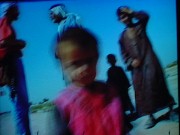 .
They are very concerned about the possibility of intensified military actions
against their country, and the ensuing effects on their communities. This
comes in addition to the anguish caused to them by eleven years of
crippling sanctions. As the .
They are very concerned about the possibility of intensified military actions
against their country, and the ensuing effects on their communities. This
comes in addition to the anguish caused to them by eleven years of
crippling sanctions. As the 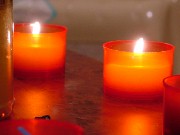 Chaldean
Bishop Shlimon put it, "Our churches in Iraq are hungry, thirsty, naked
and in prison. The Lord will ask you about this in the day of judgment.
He will say, when I was hungry you didnít feed me. Because you have
not done this for your brothers and sisters, the churches in Iraq and the
Middle East." The prophetic voice was strong and sharp. We
are weighed down by the sense that simple presence in solidarity is not
enough - Western Christians are called to concrete action. We finished
off the evening by watching a documentary, the Journey
of the Magi. For Christmas 2000, a group of pilgrims rode
camels from Iraq to Bethlehem, following the traditional journey of the
ancient kings (video - 5 sec.). Since
we were with the crowds to welcome them when
they arrived in Bethlehem, it was very interesting to see parts of
the rest of their journey. Tonight began EMEU's 33 hour prayer vigil, which
Elizabeth has been coordinating. Remarkably, she's convinced even travel-weary,
jet-lagged folks to fill up hour-long prayer slots throughout tonight and
tomorrow night. In fact, the Iraqi Chaldean Bishop signed up to start us
off at 10 tonight - three wee hours before Marthame made his way to the
vigil space in the sanctuary. "Stay awake with me." (Matthew 26) Chaldean
Bishop Shlimon put it, "Our churches in Iraq are hungry, thirsty, naked
and in prison. The Lord will ask you about this in the day of judgment.
He will say, when I was hungry you didnít feed me. Because you have
not done this for your brothers and sisters, the churches in Iraq and the
Middle East." The prophetic voice was strong and sharp. We
are weighed down by the sense that simple presence in solidarity is not
enough - Western Christians are called to concrete action. We finished
off the evening by watching a documentary, the Journey
of the Magi. For Christmas 2000, a group of pilgrims rode
camels from Iraq to Bethlehem, following the traditional journey of the
ancient kings (video - 5 sec.). Since
we were with the crowds to welcome them when
they arrived in Bethlehem, it was very interesting to see parts of
the rest of their journey. Tonight began EMEU's 33 hour prayer vigil, which
Elizabeth has been coordinating. Remarkably, she's convinced even travel-weary,
jet-lagged folks to fill up hour-long prayer slots throughout tonight and
tomorrow night. In fact, the Iraqi Chaldean Bishop signed up to start us
off at 10 tonight - three wee hours before Marthame made his way to the
vigil space in the sanctuary. "Stay awake with me." (Matthew 26) |
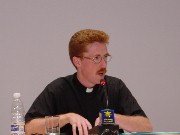 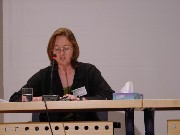 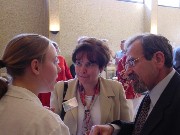 Tuesday,
5/21/02: Marthame's birthday, but little time to have a formal
celebration. Simply being here in Beirut is enough of a present.
The Conference continued full steam, with a Bible study on the meaning
of reconciliation, and then presentations and panels on expectations the
Eastern Church has of the West, the work of Christian missions, and Christian-Muslim
dialogue. We were struck that Protestant, Orthodox, and Catholic
leaders unanimously said the Eastern Church calls on the Western Church
to be a prophetic voice for truth and peace - a voice dispelling misconceptions
and misunderstandings which not only rend us from one another, but threaten
to tear the world apart along East-West lines. In particular, the
conflict in Palestine and Israel is a primary concern, mentioned again
and again by Middle eastern Christian leaders throughout the conference
and afterwards. The Anglican Bishop of Jerusalem Riah Abu-Al-Asal
delivered a keynote address on the situation affecting his parishes and
parishioners. The two of us participated in a panel on the subject, sharing
our
own perspectives on the conflict raging. We received a lot of
good responses from people - our presence in Jenin surely has given us
credibility among the Middle Easterners. It was also helpful to have
this time to reflect on how to share what's happening for when we return
to the States. Elizabeth attended the evening meetings, which offered
conferees an opportunity to discuss and share their own experiences and
work in the region. Meanwhile Marthame moved around working on a
final conference statement to put together the many voices we have heard
before we regrouped for a radio interview with CompassionRadio. Tuesday,
5/21/02: Marthame's birthday, but little time to have a formal
celebration. Simply being here in Beirut is enough of a present.
The Conference continued full steam, with a Bible study on the meaning
of reconciliation, and then presentations and panels on expectations the
Eastern Church has of the West, the work of Christian missions, and Christian-Muslim
dialogue. We were struck that Protestant, Orthodox, and Catholic
leaders unanimously said the Eastern Church calls on the Western Church
to be a prophetic voice for truth and peace - a voice dispelling misconceptions
and misunderstandings which not only rend us from one another, but threaten
to tear the world apart along East-West lines. In particular, the
conflict in Palestine and Israel is a primary concern, mentioned again
and again by Middle eastern Christian leaders throughout the conference
and afterwards. The Anglican Bishop of Jerusalem Riah Abu-Al-Asal
delivered a keynote address on the situation affecting his parishes and
parishioners. The two of us participated in a panel on the subject, sharing
our
own perspectives on the conflict raging. We received a lot of
good responses from people - our presence in Jenin surely has given us
credibility among the Middle Easterners. It was also helpful to have
this time to reflect on how to share what's happening for when we return
to the States. Elizabeth attended the evening meetings, which offered
conferees an opportunity to discuss and share their own experiences and
work in the region. Meanwhile Marthame moved around working on a
final conference statement to put together the many voices we have heard
before we regrouped for a radio interview with CompassionRadio. |
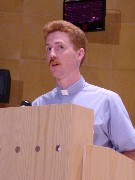 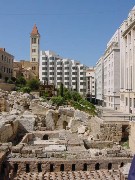 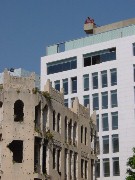 Wednesday,
5/22/02: This morning came twice for Elizabeth: once at 3 when
she headed off to her time at the vigil, which she spent in silent prayer,
some singing, and focused especially on the Church's ecumenical relations.
After an hour, she headed back to bed for a bit, and arose again at 7 in
time to grab a bite of breakfast and attend the final ceremonies. First
we all heard the Conference Statement
Marthame had been working on with - among others - an Armenian Bishop,
an Egyptian seminary professor, and an American New Testament scholar.
From there, we closed with worship and fellowship. We had to bid
farewell to some new dear friends, particularly those from the Iraqi delegation.
Marthame and the Armenian Bishop of Baghdad had shared many wonderful conversations
together. Some of us will be staying for a tour of Lebanon and Syria,
including visits to many churches, but many will be leaving soon.
And so, it is time for some goodbyes. After lunch, we headed off
to see the city we've had so little opportunity to know over the past four
days. Our first stop was to see ruins of an old Roman bath.
The floor of it was built above the stoves, supported by columns, so that
the steam from the fires would circulate and warm the water. Great
engineering. From there, we took a wider tour of downtown. There
is a massive reconstruction project underway to repair the damages of the
fifteen year civil war. Until 1990, the whole Wednesday,
5/22/02: This morning came twice for Elizabeth: once at 3 when
she headed off to her time at the vigil, which she spent in silent prayer,
some singing, and focused especially on the Church's ecumenical relations.
After an hour, she headed back to bed for a bit, and arose again at 7 in
time to grab a bite of breakfast and attend the final ceremonies. First
we all heard the Conference Statement
Marthame had been working on with - among others - an Armenian Bishop,
an Egyptian seminary professor, and an American New Testament scholar.
From there, we closed with worship and fellowship. We had to bid
farewell to some new dear friends, particularly those from the Iraqi delegation.
Marthame and the Armenian Bishop of Baghdad had shared many wonderful conversations
together. Some of us will be staying for a tour of Lebanon and Syria,
including visits to many churches, but many will be leaving soon.
And so, it is time for some goodbyes. After lunch, we headed off
to see the city we've had so little opportunity to know over the past four
days. Our first stop was to see ruins of an old Roman bath.
The floor of it was built above the stoves, supported by columns, so that
the steam from the fires would circulate and warm the water. Great
engineering. From there, we took a wider tour of downtown. There
is a massive reconstruction project underway to repair the damages of the
fifteen year civil war. Until 1990, the whole 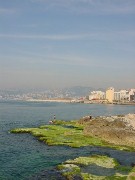 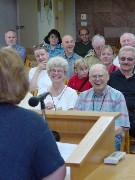 country
was torn apart by the fierce fighting of various political and military
factions. It has often been portrayed as a Muslim-Christian conflict,
but there was much more to it than that - there was Christian-Christian
fighting, Muslim-Muslim fighting, the collapse of Cold War alliances, the
Palestinian refugee crisis, and a twenty year Israeli Occupation and military country
was torn apart by the fierce fighting of various political and military
factions. It has often been portrayed as a Muslim-Christian conflict,
but there was much more to it than that - there was Christian-Christian
fighting, Muslim-Muslim fighting, the collapse of Cold War alliances, the
Palestinian refugee crisis, and a twenty year Israeli Occupation and military 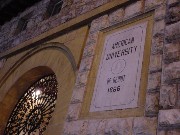 offensive.
All of this has left the country in shambles, but there is hope that democracy
is again taking root and the reconstruction will help the city reclaim
its former glory. Now, shot-up buildings stand next to brand new
ones. Restored churches are flanked by neglected ones. It's
in process, and is a sign of hope to a country that needs it. We
spent some time wandering along the coast before heading up to the Near
East School of Theology. Started in the 19th Century by Protestant
missionaries, the School has been committed to training clergy and laity
alike as has developed quite the reputation as a global center. Names
like Colin Chapman and Kenneth Bailey have been involved as faculty over
the years. NEST's president, Mary Mikhael, welcomed us along with
some of the students and took us on a tour. We had met Dr. Mikhael
when she came to First Presbyterian
Church of Wilmette before our departure two years ago - it was great
to see her again and to see NEST. The bulk of the group headed back
for dinner at sidewalk cafes in the classily-rebuilt downtown. It
felt much more like a European than offensive.
All of this has left the country in shambles, but there is hope that democracy
is again taking root and the reconstruction will help the city reclaim
its former glory. Now, shot-up buildings stand next to brand new
ones. Restored churches are flanked by neglected ones. It's
in process, and is a sign of hope to a country that needs it. We
spent some time wandering along the coast before heading up to the Near
East School of Theology. Started in the 19th Century by Protestant
missionaries, the School has been committed to training clergy and laity
alike as has developed quite the reputation as a global center. Names
like Colin Chapman and Kenneth Bailey have been involved as faculty over
the years. NEST's president, Mary Mikhael, welcomed us along with
some of the students and took us on a tour. We had met Dr. Mikhael
when she came to First Presbyterian
Church of Wilmette before our departure two years ago - it was great
to see her again and to see NEST. The bulk of the group headed back
for dinner at sidewalk cafes in the classily-rebuilt downtown. It
felt much more like a European than 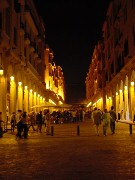 Middle
Eastern town, except for the argiles (water pipes). Meanwhile,
Elizabeth ventured off to the American University of Beirut, where her
uncle taught long ago (1948-51 and a few years in the 60s). By the time
she arrived, department offices were closed, but she did get to stoll along
the tree-lined paths and enjoy the cool evening, which also brought students
outside to play sports, attend a jazz concert or just wander. It
was very nice for her to see with her own eyes what she had only imagined
from her uncle's stories. Middle
Eastern town, except for the argiles (water pipes). Meanwhile,
Elizabeth ventured off to the American University of Beirut, where her
uncle taught long ago (1948-51 and a few years in the 60s). By the time
she arrived, department offices were closed, but she did get to stoll along
the tree-lined paths and enjoy the cool evening, which also brought students
outside to play sports, attend a jazz concert or just wander. It
was very nice for her to see with her own eyes what she had only imagined
from her uncle's stories. |
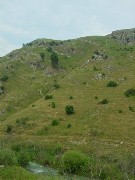 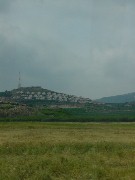 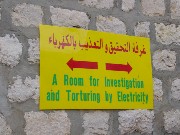 Thursday,
5/23/02: We will spend a few more days in Lebanon, but will continue
to use the Monastery as our home base. This means a lot of time spent
in busses, but the countryside in Lebanon is breathtaking. It is
far more luscious and fertile than the Galilee. Lebanon is well-known
for its ancient cedars (of which few are left, but are kept in preserves),
so much so that Solomon built his Temple from them. Lebanese see
the cedar as a national symbol - its strength endures, as does theirs.
We headed down to southern Lebanon, for which we had to receive special
visas. This is the area that was under Israel Occupation until 2000,
an occupation that ended, we were told, due to the fierce resistance of
Hezbollah. The people of the region are grateful for that liberation,
as is evident by the waving of Hezbollah's yellow flags everywhere you
go. Our first stop was to meet with church leaders in the town of
Marj Ayun at the Greek Orthodox Patriarchate. In addition to the Orthodox
bishop, we also met with the Greek Catholic (Melkite) bishop and the National
Evangelical (Presbyterian) pastor of the town. They also underscored
the importance of the Thursday,
5/23/02: We will spend a few more days in Lebanon, but will continue
to use the Monastery as our home base. This means a lot of time spent
in busses, but the countryside in Lebanon is breathtaking. It is
far more luscious and fertile than the Galilee. Lebanon is well-known
for its ancient cedars (of which few are left, but are kept in preserves),
so much so that Solomon built his Temple from them. Lebanese see
the cedar as a national symbol - its strength endures, as does theirs.
We headed down to southern Lebanon, for which we had to receive special
visas. This is the area that was under Israel Occupation until 2000,
an occupation that ended, we were told, due to the fierce resistance of
Hezbollah. The people of the region are grateful for that liberation,
as is evident by the waving of Hezbollah's yellow flags everywhere you
go. Our first stop was to meet with church leaders in the town of
Marj Ayun at the Greek Orthodox Patriarchate. In addition to the Orthodox
bishop, we also met with the Greek Catholic (Melkite) bishop and the National
Evangelical (Presbyterian) pastor of the town. They also underscored
the importance of the 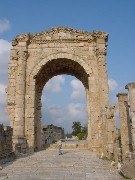 newly-received
liberation of the area as well as their deep concerns about continued Christian
emigration which is weakening all of the ancient churches in this land.
They also newly-received
liberation of the area as well as their deep concerns about continued Christian
emigration which is weakening all of the ancient churches in this land.
They also 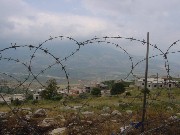 underscored
the cooperation between Christians and Muslims, something we have heard
many times over the past few weeks from leaders and people alike.
We headed from there to the infamous Al-Khiam Detention Center/Prison,
used by the Israelis and their puppet army, the SLA (Southern Lebanese
Army). We had seen a documentary on the place last year on BBC -
the evidence of torture and brutal interrogation is rampant and has fed
a lot of anger in this part of the world. It was chilling to look
at the men's and women's prison cells, the solitary confinement boxes (too
small to be called rooms) and torture posts, and then to hear from former
prisoners. The place is now run as a museum as a testament
to the suffering that took place here. The power of place and its stories was lessened by the feeling that our
presence was being capitalized on as a propaganda tool - but that's true
of most places these days on all sides of the various conflicts in the region. After lunch, we headed up to Sour, the
site of ancient Tyre. Jesus once ministered here (Matthew 15), a
reminder that in his days the borders between these places were a lot more
flexible than they are now. We entered the ruins of ancient Tyre
by way of the necropolis, heading
towards the central attraction, the massive hippodrome, where we stopped
to reflect on Jesus' passing through underscored
the cooperation between Christians and Muslims, something we have heard
many times over the past few weeks from leaders and people alike.
We headed from there to the infamous Al-Khiam Detention Center/Prison,
used by the Israelis and their puppet army, the SLA (Southern Lebanese
Army). We had seen a documentary on the place last year on BBC -
the evidence of torture and brutal interrogation is rampant and has fed
a lot of anger in this part of the world. It was chilling to look
at the men's and women's prison cells, the solitary confinement boxes (too
small to be called rooms) and torture posts, and then to hear from former
prisoners. The place is now run as a museum as a testament
to the suffering that took place here. The power of place and its stories was lessened by the feeling that our
presence was being capitalized on as a propaganda tool - but that's true
of most places these days on all sides of the various conflicts in the region. After lunch, we headed up to Sour, the
site of ancient Tyre. Jesus once ministered here (Matthew 15), a
reminder that in his days the borders between these places were a lot more
flexible than they are now. We entered the ruins of ancient Tyre
by way of the necropolis, heading
towards the central attraction, the massive hippodrome, where we stopped
to reflect on Jesus' passing through 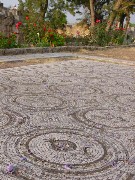 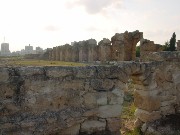 here. We're trying to take time
along these two weeks to do some Bible study in different places to reflect
on the meaning of our time here. We stopped in Sidon for ice cream
on our journey home, a welcome break in a long day of bus travel.
It was an intense day, a difficult one to sort through - meeting with bishops,
seeing the prison and signs of Hezbollah, and walking through the ancient ruins
- all images that swirl in our minds, as we try to sift through it all
and understand this region better. here. We're trying to take time
along these two weeks to do some Bible study in different places to reflect
on the meaning of our time here. We stopped in Sidon for ice cream
on our journey home, a welcome break in a long day of bus travel.
It was an intense day, a difficult one to sort through - meeting with bishops,
seeing the prison and signs of Hezbollah, and walking through the ancient ruins
- all images that swirl in our minds, as we try to sift through it all
and understand this region better. |
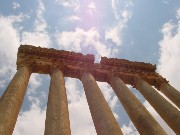 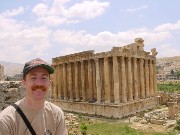 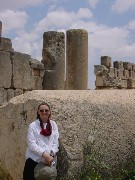 Friday,
5/24/02: Another long bus ride, another set of ruins, this time
the spectacular site of Baalbeck. These are more impressive than
those of Tyre, including a temple at the center of it all that is mostly
intact. Amazing stuff. We then went off to the city of Zahle
to visit with the Syrian Orthodox bishop there. The Syrian, Armenian,
and Coptic Orthodox churches are part of what are known as the non-Chalcedonic
churches. At the fifth century Council of Chalcedon, the debate was
on Christology - was Christ fully human, fully divine, or both? Most of
the churches decided the latter, but those three (for reasons theological
and political) chose to say that Christ was God merely appearing to be
human. This has been the source of controversy and division through
the centuries. In the West, we come in contact with these ancient
debates and heresies afresh through movements like fundamentalism and historical
Jesus studies. One feature of the Syrian Friday,
5/24/02: Another long bus ride, another set of ruins, this time
the spectacular site of Baalbeck. These are more impressive than
those of Tyre, including a temple at the center of it all that is mostly
intact. Amazing stuff. We then went off to the city of Zahle
to visit with the Syrian Orthodox bishop there. The Syrian, Armenian,
and Coptic Orthodox churches are part of what are known as the non-Chalcedonic
churches. At the fifth century Council of Chalcedon, the debate was
on Christology - was Christ fully human, fully divine, or both? Most of
the churches decided the latter, but those three (for reasons theological
and political) chose to say that Christ was God merely appearing to be
human. This has been the source of controversy and division through
the centuries. In the West, we come in contact with these ancient
debates and heresies afresh through movements like fundamentalism and historical
Jesus studies. One feature of the Syrian 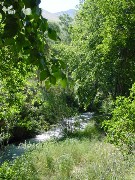 (or
Syriac) church is their continued liturgical use of Aramaic, the language
of Christ. They consider themselves the safeguarders of this ancient
treasure. After lunch and conversation together, we visited the church
where the Bishop and some priests prayed the Lord's Prayer in - most likely
- its original language (audio - 40 sec.).
Haunting and moving. From there, we visited the town of Zahle, which
is a fairly large, all-Christian city tucked along either side of a steep
valley cut (or
Syriac) church is their continued liturgical use of Aramaic, the language
of Christ. They consider themselves the safeguarders of this ancient
treasure. After lunch and conversation together, we visited the church
where the Bishop and some priests prayed the Lord's Prayer in - most likely
- its original language (audio - 40 sec.).
Haunting and moving. From there, we visited the town of Zahle, which
is a fairly large, all-Christian city tucked along either side of a steep
valley cut 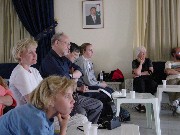 into
the mountainside by a fast-moving stream. One of our hosts recalled
sneaking medical supplies into the hospital there during the war.
We walked along the cascading river, watching kids play in the bumper-car
arenas and stopping for some ice cream and fresh bread. The tables
of the restaurants which bordered the river overflowed with fresh fruit
- cherries, oranges, watermelons, loquats (askadinia). We
then headed off to the "Anti-Lebanon" mountains (which face the Lebanon
range), towards the Presbyterian Retreat Center for the Synod of Lebanon
and Syria. Along the way, we saw many bombed out houses that remain
unrepaired from the 70s and 80s. We also saw many Syrian flags and
many Syrian soldiers, not something we were expecting to see in Lebanon.
During the civil war, Lebanon invited Syria to intervene. They did,
and they have not yet left. Lebanon isn't strong enough yet to ask
them to leave, either. Syrian soldiers in the East and Hezbollah
in the South are part of the remaining problems facing a united Lebanon.
The retreat center sits overlooking a dramatic valley. It has been
there since the mid-19th century, serving the Protestant (Presbyterian)
churches of the whole region - people used to come from as far as Egypt
and Iraq for summer programs. The region has into
the mountainside by a fast-moving stream. One of our hosts recalled
sneaking medical supplies into the hospital there during the war.
We walked along the cascading river, watching kids play in the bumper-car
arenas and stopping for some ice cream and fresh bread. The tables
of the restaurants which bordered the river overflowed with fresh fruit
- cherries, oranges, watermelons, loquats (askadinia). We
then headed off to the "Anti-Lebanon" mountains (which face the Lebanon
range), towards the Presbyterian Retreat Center for the Synod of Lebanon
and Syria. Along the way, we saw many bombed out houses that remain
unrepaired from the 70s and 80s. We also saw many Syrian flags and
many Syrian soldiers, not something we were expecting to see in Lebanon.
During the civil war, Lebanon invited Syria to intervene. They did,
and they have not yet left. Lebanon isn't strong enough yet to ask
them to leave, either. Syrian soldiers in the East and Hezbollah
in the South are part of the remaining problems facing a united Lebanon.
The retreat center sits overlooking a dramatic valley. It has been
there since the mid-19th century, serving the Protestant (Presbyterian)
churches of the whole region - people used to come from as far as Egypt
and Iraq for summer programs. The region has 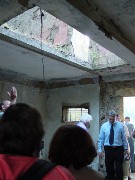 undergone
dramatic undergone
dramatic 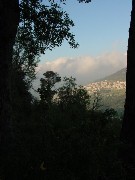 changes
that make that almost impossible. Now the center serves primarily just
the Synod of Lebonon and Syria, which includes about 45 congregations.
Only recently did the Center re-open after being occupied by various military
groups, engaged in house-to-house combat on the property. The whole
place needed to be rebuilt, and it is quite well along the way. Some
significant damage remains, including the wreckage of the cabin where one-time
hostage Benjamin Weir and his family used to stay in when they visited
from Beirut. The Center's director, Najle Kassab, is a graduate of
Princeton Seminary and the first female licensed preacher in the denomination.
With us were a number of women who had arrived from many congregations
in Syria and Lebanon for a retreat and bible study, preparing them to teach
the letter of James to their women's groups upon returning home. We shared
in fellowship, prayer, and dinner before making the long, late drive back
to the Monastery. Tomorrow, we head up north... changes
that make that almost impossible. Now the center serves primarily just
the Synod of Lebonon and Syria, which includes about 45 congregations.
Only recently did the Center re-open after being occupied by various military
groups, engaged in house-to-house combat on the property. The whole
place needed to be rebuilt, and it is quite well along the way. Some
significant damage remains, including the wreckage of the cabin where one-time
hostage Benjamin Weir and his family used to stay in when they visited
from Beirut. The Center's director, Najle Kassab, is a graduate of
Princeton Seminary and the first female licensed preacher in the denomination.
With us were a number of women who had arrived from many congregations
in Syria and Lebanon for a retreat and bible study, preparing them to teach
the letter of James to their women's groups upon returning home. We shared
in fellowship, prayer, and dinner before making the long, late drive back
to the Monastery. Tomorrow, we head up north... |
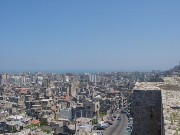 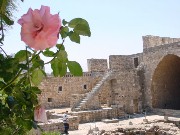 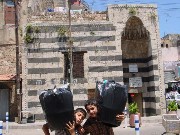 Saturday,
5/25/02: This morning we headed up to Tripoli (in Arabic, Tarablus),
the Northern capital of Lebanon. It is a great deal poorer than Beirut
and has not received the re-building attention that Beirut has. The
main street there was lined with pictures of the parliament leader who
is headed up to the North next week to ask for a local woman's hand in
marriage to his son. For the time being at least, he seems very popular.
Our first stop was the old Crusader Citadel of Sinjil (the Arabization
of the ancient name "Saint Gilles"), which gives a view over the slums
of Tarablus and on towards the Mediterranean Sea. One person suggested
tearing down the Citadel to provide for more housing - not a bad idea.
We then headed back a bit South to Belmont Abbey (known locally as "Balamond")
and Balamond University, a Greek Orthodox institute. After lunch
and a conversation with a local man working with Saturday,
5/25/02: This morning we headed up to Tripoli (in Arabic, Tarablus),
the Northern capital of Lebanon. It is a great deal poorer than Beirut
and has not received the re-building attention that Beirut has. The
main street there was lined with pictures of the parliament leader who
is headed up to the North next week to ask for a local woman's hand in
marriage to his son. For the time being at least, he seems very popular.
Our first stop was the old Crusader Citadel of Sinjil (the Arabization
of the ancient name "Saint Gilles"), which gives a view over the slums
of Tarablus and on towards the Mediterranean Sea. One person suggested
tearing down the Citadel to provide for more housing - not a bad idea.
We then headed back a bit South to Belmont Abbey (known locally as "Balamond")
and Balamond University, a Greek Orthodox institute. After lunch
and a conversation with a local man working with 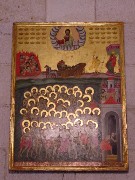 Palestinian
refugees and their rights, we headed Palestinian
refugees and their rights, we headed 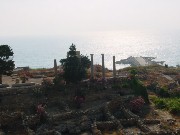 over
to visit with one of their seminarians. Balamond seminary is a center
in the Middle East for Greek/Antiochian Orthodox clergy, and it currently
has about 100 students (70 undergraduate theology students and 30 graduate
students). At each of the Byzantine churches that we've visited,
we've been learning more and more about the Eastern tradition. Even
among the PhDs in our group, there is very little knowledge in the West
of Orthodox theology. Our focus is so much on Western theological
controversies and histories that we tend to forget the traditions that
are so rooted in this land. As one priest among our group patiently
explained, the prime difference between Protestants and Orthodox is that
Protestants look to the Bible for their guidance, while the Orthodox look
to the Tradition for theirs - tradition of which Scripture is a part.
Iconography, said to have originated with St. Luke's painting an icon of
Mary and child, is another part. Each icon has an original, of which
all writings (icons are written, not painted) are emulations. As
with the Scripture we currently have, icons have an original "text," which
has been copied and handed down through generations. A canon of image to
complement the canon of the Word - we have much to learn. Our last
stop for the day was the ruins of the ancient port city of Byblos.
Given the bus conversations about Scripture and iconography, it was a fitting
place to reflect. The name "Byblos" comes from the Greek word for
papyrus, an export this town was well-known for. "Books" were simply
bound-together over
to visit with one of their seminarians. Balamond seminary is a center
in the Middle East for Greek/Antiochian Orthodox clergy, and it currently
has about 100 students (70 undergraduate theology students and 30 graduate
students). At each of the Byzantine churches that we've visited,
we've been learning more and more about the Eastern tradition. Even
among the PhDs in our group, there is very little knowledge in the West
of Orthodox theology. Our focus is so much on Western theological
controversies and histories that we tend to forget the traditions that
are so rooted in this land. As one priest among our group patiently
explained, the prime difference between Protestants and Orthodox is that
Protestants look to the Bible for their guidance, while the Orthodox look
to the Tradition for theirs - tradition of which Scripture is a part.
Iconography, said to have originated with St. Luke's painting an icon of
Mary and child, is another part. Each icon has an original, of which
all writings (icons are written, not painted) are emulations. As
with the Scripture we currently have, icons have an original "text," which
has been copied and handed down through generations. A canon of image to
complement the canon of the Word - we have much to learn. Our last
stop for the day was the ruins of the ancient port city of Byblos.
Given the bus conversations about Scripture and iconography, it was a fitting
place to reflect. The name "Byblos" comes from the Greek word for
papyrus, an export this town was well-known for. "Books" were simply
bound-together 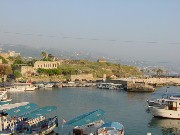 sheets
of papyrus 2000 thousand years ago, and the Bible derives its name
from that word - and, indirectly, this place. We reflected on that
amidst the ruins of ancient Byblos, sheets
of papyrus 2000 thousand years ago, and the Bible derives its name
from that word - and, indirectly, this place. We reflected on that
amidst the ruins of ancient Byblos, 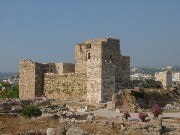 most
prominently three layers (each carefully excavated and moved to a display
site) of a Phoenician temple site. It was in the "Obelisk" temple" that
small gold-encrusted human figurines were found (and copies of which inhabit
every tourist kiosk nearby). And at the nearby royal tombs was found a
sarcophagus inscribed with an early Phoenecian alphabet (lauded as
the mother of all alphabets). Copies of this, too, are available for sale
nearby. We then wandered over to modern Byblos for some shopping, stumbling
across a shop which deals in fish fossils. Due to a massive fish
kill 100 million years ago (from plankton waterbloom) and propitious preservation
conditions, much more than half of the world's fish fossils come from Byblos!
We then found our way to the marina where we ate some fish that was a little
fresher than that, enjoying the lovely sunset over the Mediterranean.
Our last full day in Lebanon on this trip, but we have a feeling it won't
be our last time. most
prominently three layers (each carefully excavated and moved to a display
site) of a Phoenician temple site. It was in the "Obelisk" temple" that
small gold-encrusted human figurines were found (and copies of which inhabit
every tourist kiosk nearby). And at the nearby royal tombs was found a
sarcophagus inscribed with an early Phoenecian alphabet (lauded as
the mother of all alphabets). Copies of this, too, are available for sale
nearby. We then wandered over to modern Byblos for some shopping, stumbling
across a shop which deals in fish fossils. Due to a massive fish
kill 100 million years ago (from plankton waterbloom) and propitious preservation
conditions, much more than half of the world's fish fossils come from Byblos!
We then found our way to the marina where we ate some fish that was a little
fresher than that, enjoying the lovely sunset over the Mediterranean.
Our last full day in Lebanon on this trip, but we have a feeling it won't
be our last time. |
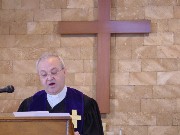 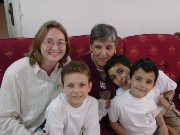 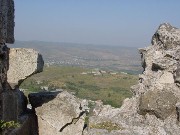 Sunday,
5/26/02: We began the day in worship at Tripoli's Presbyterian
Church, which had been totally destroyed in the war. The Synod was able
to rebuild the edifice, but not its numbers: before the war it served about
200 families. Now maybe 50 remain. After multi-lingual worship and
fellowship (the Lebanese accent is difficult for us "Palestinians"!), we
headed off for the second half of our trip across the Syrian border.
Due to our residence of the last two years, and due to relations between
Syria and Israel (and the fact that our visa stamp comes from Israel),
crossing into Syria is usually impossible. Even with a second passport,
it is difficult - the authorities will grill it with an aim to uncovering
how you might have entered Israel at some point. Thus, entering with
a group - at least for the time being - was the best way for us to get
here. While we waited at the border crossing, the pastor of the nearby
Presbyterian church and his wife brought us an Sunday,
5/26/02: We began the day in worship at Tripoli's Presbyterian
Church, which had been totally destroyed in the war. The Synod was able
to rebuild the edifice, but not its numbers: before the war it served about
200 families. Now maybe 50 remain. After multi-lingual worship and
fellowship (the Lebanese accent is difficult for us "Palestinians"!), we
headed off for the second half of our trip across the Syrian border.
Due to our residence of the last two years, and due to relations between
Syria and Israel (and the fact that our visa stamp comes from Israel),
crossing into Syria is usually impossible. Even with a second passport,
it is difficult - the authorities will grill it with an aim to uncovering
how you might have entered Israel at some point. Thus, entering with
a group - at least for the time being - was the best way for us to get
here. While we waited at the border crossing, the pastor of the nearby
Presbyterian church and his wife brought us an 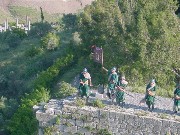 extravagant
lunch on extravagant
lunch on 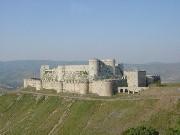 the
bus - meat and cheese pies, beverages, even dessert! There was more
than enough to go around (and then some). This, combined with the
fact that they were allowed into the military border control area because
they were delivering food, was a potent reminder of Middle Eastern hospitality.
We then headed past towns like Homs for our evening resting place in Wadi
al-Nasara (the Christian Valley), so named because of the presence of so
many Christian towns and villages through the centuries. Syria has
an estimated Christian population somewhere between ten and fifteen percent.
It's not as much as in Lebanon (nearly half) or as numerous as Egypt (in
the millions), but it's at least twice the percent in Iraq - which is more
than twice that of Israel, Palestine, and Jordan. Our hotel rests beneath
the shadow of the
Krak des Chevaliers, the mother/grandpappy of
all Crusader castles. It was so long ago that it is hard to remember
at times that the Crusaders held great portions of this whole area for
a couple hundred years - it seems like a blip in history, but it is good
to recall that it's about as long as our nation has existed. While
we were exploring the immensity of the castle, we saw a Jordanian group
filming a historical drama for TV. Seeing the actors decked out in
costumes was jarring, especially as they were surrounded by the modernity
of the
bus - meat and cheese pies, beverages, even dessert! There was more
than enough to go around (and then some). This, combined with the
fact that they were allowed into the military border control area because
they were delivering food, was a potent reminder of Middle Eastern hospitality.
We then headed past towns like Homs for our evening resting place in Wadi
al-Nasara (the Christian Valley), so named because of the presence of so
many Christian towns and villages through the centuries. Syria has
an estimated Christian population somewhere between ten and fifteen percent.
It's not as much as in Lebanon (nearly half) or as numerous as Egypt (in
the millions), but it's at least twice the percent in Iraq - which is more
than twice that of Israel, Palestine, and Jordan. Our hotel rests beneath
the shadow of the
Krak des Chevaliers, the mother/grandpappy of
all Crusader castles. It was so long ago that it is hard to remember
at times that the Crusaders held great portions of this whole area for
a couple hundred years - it seems like a blip in history, but it is good
to recall that it's about as long as our nation has existed. While
we were exploring the immensity of the castle, we saw a Jordanian group
filming a historical drama for TV. Seeing the actors decked out in
costumes was jarring, especially as they were surrounded by the modernity
of 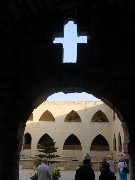 lights,
cables, and lights,
cables, and 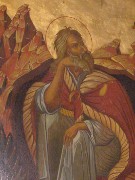 cameras.
We also enjoyed seeing the mix of Crusader and later Mamluk architecture
in the building. Most of the 40 villages in the Valley below have
remained Christian, with the exception - ironically, perhaps - of the village
closest to the Krak. In the Valley, we visited St.
George's Monastery, another Greek Orthodox site. With fifteen
monks and a 1500 year old church, they also have active summer camps, especially
for youth and laity, including training in Byzantine music, some of which
they sang for us in the ancient chapel. A return trip might be in
order. One interesting piece of history there is a document from
the time of Mohammed's followers which explicitly forbids anyone from touching
the Monastery. Given the Crusader history (which was not kind to
the indigenous Orthodox communities either), having such a document has
been helpful in the passing centuries. It is written in an elegant,
almost illegible ancient Arabic, then "translated" to a more modern script.
We headed back to the hotel for supper before gathering out on the balcony
to de-brief. Given our recent experiences, it seemed like a necessary
thing to do. Much of the talk centered around strategy - how do we
share these stories when we get back? It's a good question, one that
we're asking ourselves a lot as we get ready to head back for two months
of visits State-side this summer. Looks like it's one we'll be asking
for a while. cameras.
We also enjoyed seeing the mix of Crusader and later Mamluk architecture
in the building. Most of the 40 villages in the Valley below have
remained Christian, with the exception - ironically, perhaps - of the village
closest to the Krak. In the Valley, we visited St.
George's Monastery, another Greek Orthodox site. With fifteen
monks and a 1500 year old church, they also have active summer camps, especially
for youth and laity, including training in Byzantine music, some of which
they sang for us in the ancient chapel. A return trip might be in
order. One interesting piece of history there is a document from
the time of Mohammed's followers which explicitly forbids anyone from touching
the Monastery. Given the Crusader history (which was not kind to
the indigenous Orthodox communities either), having such a document has
been helpful in the passing centuries. It is written in an elegant,
almost illegible ancient Arabic, then "translated" to a more modern script.
We headed back to the hotel for supper before gathering out on the balcony
to de-brief. Given our recent experiences, it seemed like a necessary
thing to do. Much of the talk centered around strategy - how do we
share these stories when we get back? It's a good question, one that
we're asking ourselves a lot as we get ready to head back for two months
of visits State-side this summer. Looks like it's one we'll be asking
for a while. |
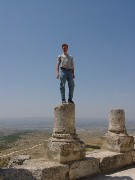 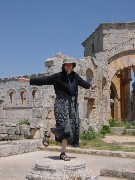 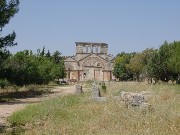 Monday,
5/27/02: On the road again today (theme
music courtesy of Willie Nelson - 3 sec.). We've packed up our
bags, and piled them on the bus for another day on the move (it'll be that
way for a while, but Syria's so big, there's no other way to see the country).
Our first stop was at what is now called Simon's Citadel, but is famous
for its ruins (video - 22 sec.) and one
of its former residents, St. Simeon Stylites. As the Christian world
was struggling with Constantine's tolerance, there were many reactions.
One, among the monastic community, was to reject the world that much more
and take a harsher approach. Simeon was one such character, heading
out into the desert for the life of a stoic hermit. However, his
peace and solace was disturbed as his fame spread. Eventually, he moved
to live on top of a column to get away from the crowds of people who began
to follow him. It also gave him the opportunity to take literally Jesus'
words to "consider the birds of the air." (Matthew 6) The higher his column,
the more people came to appeal for his teaching and wisdom; thus it cycled
until he lived on a platform atop a column sixty feet high. We were told
that he had a chain around his neck attached to the column so that he wouldn't
fall off in his sleep. Tradition has it that one night, a bishop
was raised up to ordain him (against his will) while he was sleeping.
In 491, after his death, an Monday,
5/27/02: On the road again today (theme
music courtesy of Willie Nelson - 3 sec.). We've packed up our
bags, and piled them on the bus for another day on the move (it'll be that
way for a while, but Syria's so big, there's no other way to see the country).
Our first stop was at what is now called Simon's Citadel, but is famous
for its ruins (video - 22 sec.) and one
of its former residents, St. Simeon Stylites. As the Christian world
was struggling with Constantine's tolerance, there were many reactions.
One, among the monastic community, was to reject the world that much more
and take a harsher approach. Simeon was one such character, heading
out into the desert for the life of a stoic hermit. However, his
peace and solace was disturbed as his fame spread. Eventually, he moved
to live on top of a column to get away from the crowds of people who began
to follow him. It also gave him the opportunity to take literally Jesus'
words to "consider the birds of the air." (Matthew 6) The higher his column,
the more people came to appeal for his teaching and wisdom; thus it cycled
until he lived on a platform atop a column sixty feet high. We were told
that he had a chain around his neck attached to the column so that he wouldn't
fall off in his sleep. Tradition has it that one night, a bishop
was raised up to ordain him (against his will) while he was sleeping.
In 491, after his death, an 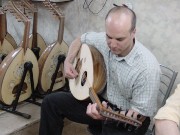 enormous
cathedral was erected over the spot. It was quite the pilgrimage
spot for centuries. Now, it is quite the impressive collection enormous
cathedral was erected over the spot. It was quite the pilgrimage
spot for centuries. Now, it is quite the impressive collection 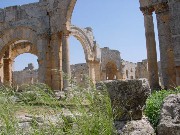 of
ruins. We reflected on these things as our Melkite companion shared
St. Simeon's prayer with us (audio - 17
sec.). After lunch, we headed off to Aleppo (Halab in Arabic).
Along the way, we passed the town of Hama, famous for its enormous, graceful
wooden waterwheels, constructed by the Ayyubids (whose rule began following
Salah ad-Din/Saladin). The town is also infamous for a massacre which took
place there during the presidency of Hafez al-Assad (Bishara's father).
The Muslim brotherhood had taken up residence there, using it as a base
to plan violent radicalism (frequent bombings, assassinations). The
army, trying to put a stop to such efforts, surrounded the town and demanded
evacuation of all civilians and surrender of all militants. Few complied.
They then stormed the place. Reports of casualties buried in mass
graves range as high as 20,000, but no one is sure. As our guide
justified this brutality, the rhetoric sounded eerily familiar to Israeli
descriptions of the battle of Jenin. We arrived in Aleppo and headed
out to investigate the city, our first real chance to wander unchaperoned
in Syria. We went shopping for an 'oud with one of our group, of
ruins. We reflected on these things as our Melkite companion shared
St. Simeon's prayer with us (audio - 17
sec.). After lunch, we headed off to Aleppo (Halab in Arabic).
Along the way, we passed the town of Hama, famous for its enormous, graceful
wooden waterwheels, constructed by the Ayyubids (whose rule began following
Salah ad-Din/Saladin). The town is also infamous for a massacre which took
place there during the presidency of Hafez al-Assad (Bishara's father).
The Muslim brotherhood had taken up residence there, using it as a base
to plan violent radicalism (frequent bombings, assassinations). The
army, trying to put a stop to such efforts, surrounded the town and demanded
evacuation of all civilians and surrender of all militants. Few complied.
They then stormed the place. Reports of casualties buried in mass
graves range as high as 20,000, but no one is sure. As our guide
justified this brutality, the rhetoric sounded eerily familiar to Israeli
descriptions of the battle of Jenin. We arrived in Aleppo and headed
out to investigate the city, our first real chance to wander unchaperoned
in Syria. We went shopping for an 'oud with one of our group, 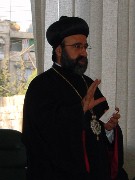 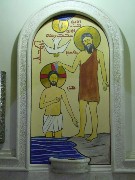 an
ethno-musicologist from California with Lebanese heritage. We found
one store, where we visited and played some music with the management (audio
- 14 sec.). Afterwards, we attended an ecumenical conference with
the Syrian Orthodox Metropolitan of Aleppo, a Syrian Orthodox priest, Greek
Orthodox priest, and the minister of Aleppo's Armenian Evangelical church.
The conversation ranged, as usual, but one item of great interest was that
of Christian-Muslim relations. According to all the leaders represented an
ethno-musicologist from California with Lebanese heritage. We found
one store, where we visited and played some music with the management (audio
- 14 sec.). Afterwards, we attended an ecumenical conference with
the Syrian Orthodox Metropolitan of Aleppo, a Syrian Orthodox priest, Greek
Orthodox priest, and the minister of Aleppo's Armenian Evangelical church.
The conversation ranged, as usual, but one item of great interest was that
of Christian-Muslim relations. According to all the leaders represented 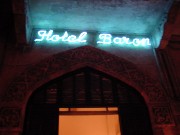 there,
the Syrian church shares great relations with the majority Muslim culture.
Stumbling blocks remain, of course, especially that of intermarriage and
conversion (a "one-way street", they said). Aleppo is a center of
Christian population in Syria, and the Syrian government has been very
intentional about maintaining religious tolerance. Syrian churches
enjoy free electricity from the goverment, as well as help with building
new churches. Given the image we receive in the West, such messages
are not only surprising, they are welcome. We headed down to the
church for shared prayers - the Syrians praying the Lord's Prayer in Arabic
(audio - 40 sec.), the Greeks praying "Christ
is Risen", and us singing the Doxology. After dinner at our hotel,
overlooking the enormous cathedral at the center of town, a few of us headed
towards the storied Hotel Baron for drinks. A vision of faded grandeur,
the Baron is famous for its former guests, including Agatha Christie and
Laurence of Arabia. We soaked in the ambience (and a little arak)
before heading back to get a few hours of sleep. there,
the Syrian church shares great relations with the majority Muslim culture.
Stumbling blocks remain, of course, especially that of intermarriage and
conversion (a "one-way street", they said). Aleppo is a center of
Christian population in Syria, and the Syrian government has been very
intentional about maintaining religious tolerance. Syrian churches
enjoy free electricity from the goverment, as well as help with building
new churches. Given the image we receive in the West, such messages
are not only surprising, they are welcome. We headed down to the
church for shared prayers - the Syrians praying the Lord's Prayer in Arabic
(audio - 40 sec.), the Greeks praying "Christ
is Risen", and us singing the Doxology. After dinner at our hotel,
overlooking the enormous cathedral at the center of town, a few of us headed
towards the storied Hotel Baron for drinks. A vision of faded grandeur,
the Baron is famous for its former guests, including Agatha Christie and
Laurence of Arabia. We soaked in the ambience (and a little arak)
before heading back to get a few hours of sleep. |
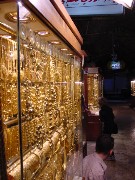 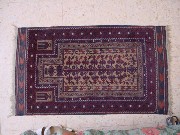 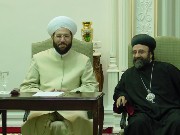 Tuesday,
5/28/02: We began our day at the souq (market) for some
shopping time. The souq is quite expansive, and the entire maze
is covered - a pleasant luxury when the dust is blowing and the sun is
pounding down outside. Elizabeth bumped into an American neurologist
who first came to Syria 20 years ago on a Fulbright. With his assistance,
she ended up buying a rug! This was something she had hoped sometime to
do during her time in the Middle East, but which has utterly intimidated
her. But a deal was made (largely because of the neurologist's help and
Elizabeth's willingness to walk away to catch the bus). We then headed
off to meet with Sheikh Ahmed Hassoun, the Grand
Mufti of Aleppo. He and Metropolitan Ibrahim (Syrian Orthodox) together
received us in the mosque. Sheikh Hassoun spoke of religious tolerance,
noting that as a youth, he prayed in Jerusalem and Bethlehem churches.
Jews, he pointed out, have lived in Syria throughout history and
they were free to visit their shrines. However, in his estimation, extremists
in all religions think they Tuesday,
5/28/02: We began our day at the souq (market) for some
shopping time. The souq is quite expansive, and the entire maze
is covered - a pleasant luxury when the dust is blowing and the sun is
pounding down outside. Elizabeth bumped into an American neurologist
who first came to Syria 20 years ago on a Fulbright. With his assistance,
she ended up buying a rug! This was something she had hoped sometime to
do during her time in the Middle East, but which has utterly intimidated
her. But a deal was made (largely because of the neurologist's help and
Elizabeth's willingness to walk away to catch the bus). We then headed
off to meet with Sheikh Ahmed Hassoun, the Grand
Mufti of Aleppo. He and Metropolitan Ibrahim (Syrian Orthodox) together
received us in the mosque. Sheikh Hassoun spoke of religious tolerance,
noting that as a youth, he prayed in Jerusalem and Bethlehem churches.
Jews, he pointed out, have lived in Syria throughout history and
they were free to visit their shrines. However, in his estimation, extremists
in all religions think they 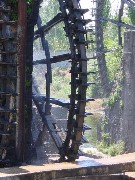 have
a monopoly on God. Listening to religious authorities, one always wonders
how much is rhetoric and how much is sincere; to us Sheikh Ahmed seemed
sincerely to be working hard against radicalism in his community.
He stated that the have
a monopoly on God. Listening to religious authorities, one always wonders
how much is rhetoric and how much is sincere; to us Sheikh Ahmed seemed
sincerely to be working hard against radicalism in his community.
He stated that the 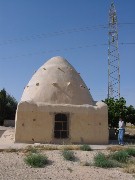 beginning
of radicalism in Islam is simultaneous with the establishment of Israel,
and that Israel is the only country in the region to expropriate the name
of a prophet for its nation (Israel, that is, the name given to Jacob).
He ended with a call: "We need to join hands and create heaven on earth."
After the meeting began our long drive to the ruins of Palmyra, stopping
along the way for lunch under the shade of more ancient water wheels.
Palmyra is an oasis in the middle of the Syrian desert, so the drive brought
us into sand, sand, and more sand. Along the road were the most curious
structures, houses shaped like bee hives. These ancient homes dotted
the landscape like teepees, built out of mud and reinforced ever so often
with more mud. We stopped to see some up close. Many of them
were abandoned long ago, but bedouins have taken to living in them.
This is a common phenomenon in other parts of Syria as well, in the so-called
"cities of the dead." Old, vacant towns are left from Byzantine times,
and new residents - such as bedouins - come to live in their ruins and
use the ancient structures as building materials. Such is the richness
of Syria's ancient treasures that this practice is very widespread.
The jewel in the crown of Syria's ruins is Palmyra. We arrived at
our hotel, the Zenobia, built right at the center of the ruins (possibly
over Queen Zenobia's palace). Because of this, it likely won't be
here much longer, so to stay here is a treat. Some went off for camel
rides, others to bargain with the barkers who wait at the beginning
of radicalism in Islam is simultaneous with the establishment of Israel,
and that Israel is the only country in the region to expropriate the name
of a prophet for its nation (Israel, that is, the name given to Jacob).
He ended with a call: "We need to join hands and create heaven on earth."
After the meeting began our long drive to the ruins of Palmyra, stopping
along the way for lunch under the shade of more ancient water wheels.
Palmyra is an oasis in the middle of the Syrian desert, so the drive brought
us into sand, sand, and more sand. Along the road were the most curious
structures, houses shaped like bee hives. These ancient homes dotted
the landscape like teepees, built out of mud and reinforced ever so often
with more mud. We stopped to see some up close. Many of them
were abandoned long ago, but bedouins have taken to living in them.
This is a common phenomenon in other parts of Syria as well, in the so-called
"cities of the dead." Old, vacant towns are left from Byzantine times,
and new residents - such as bedouins - come to live in their ruins and
use the ancient structures as building materials. Such is the richness
of Syria's ancient treasures that this practice is very widespread.
The jewel in the crown of Syria's ruins is Palmyra. We arrived at
our hotel, the Zenobia, built right at the center of the ruins (possibly
over Queen Zenobia's palace). Because of this, it likely won't be
here much longer, so to stay here is a treat. Some went off for camel
rides, others to bargain with the barkers who wait at the 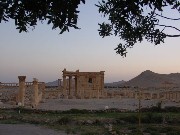 edge
of the hotel parking lot. The rest enjoyed the desert coolness as
the moon lit up the scattered columns. edge
of the hotel parking lot. The rest enjoyed the desert coolness as
the moon lit up the scattered columns. |
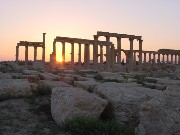 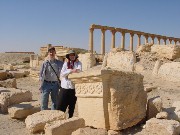 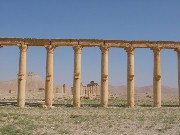 Wednesday,
5/29/02: Palmyra! (theme music
courtesy of the Oak Ridge Boys - 4 sec.) Elizabeth woke up at a quarter
to 5:00 and saw the first rosy hints of sunrise competing with the light
of the full moon. Without hesitation, she pulled on shoes and a warm jacket
and headed out to wander among the ruins. She intended only to go to the
closest columns and then return to bed, but the views and the light were
so beautiful that she couldnt go back until the sun came up. In her wanderings,
not only did she see the grand site in beautiful light without an entourage
of postard and kaffiye hawkers, she also followed her ears to an
owl and its young atop some columns, and peered at a dung beetle busy at
work with its precious ball. She returned to the hotel after watching
the sun rise through the cream-colored ancient remains of the city. As
a group, we went out after breakfast to see more ruins, and more ruins
- Wednesday,
5/29/02: Palmyra! (theme music
courtesy of the Oak Ridge Boys - 4 sec.) Elizabeth woke up at a quarter
to 5:00 and saw the first rosy hints of sunrise competing with the light
of the full moon. Without hesitation, she pulled on shoes and a warm jacket
and headed out to wander among the ruins. She intended only to go to the
closest columns and then return to bed, but the views and the light were
so beautiful that she couldnt go back until the sun came up. In her wanderings,
not only did she see the grand site in beautiful light without an entourage
of postard and kaffiye hawkers, she also followed her ears to an
owl and its young atop some columns, and peered at a dung beetle busy at
work with its precious ball. She returned to the hotel after watching
the sun rise through the cream-colored ancient remains of the city. As
a group, we went out after breakfast to see more ruins, and more ruins
- 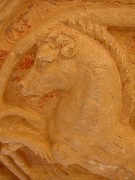 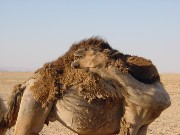 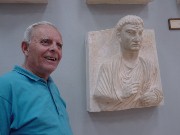 collonaded
streets, temples turned into churches turned into stones, monoliths, great
treasures everywhere. Because of the (slightly sulfurous) springs
nearby, the city developed as an oasis for the massive caravans passing
through the area. The Hebrew Bible even records that King Solomon
built at "Tadmor", the Arabic name for the place (II Chron. 8). Several
hours was not enough to see or understand it all. After a rest and
a refreshing drink, it was off to visit the tombs. Outside the walls
of the Old City lies Palmyra's cemetery. The Greco-Roman residents
would build large family tombs, stacking members several high and placing
a life-like relief carved in stone (all of which have been removed) in
front of the tomb. More and more are being discovered all of the
time, and many simply remained buried to preserve them. We entered
one, which could have contained nearly 200 bodies. After lunch, while
Marthame enjoyed the modernity of a hotel swimming pool, Elizabeth headed
off to modern Tadmor to visit the museum and to do some shopping. The museum
was not especially impressive, but it did have many of the relief-carved
burial stones, which gave a collonaded
streets, temples turned into churches turned into stones, monoliths, great
treasures everywhere. Because of the (slightly sulfurous) springs
nearby, the city developed as an oasis for the massive caravans passing
through the area. The Hebrew Bible even records that King Solomon
built at "Tadmor", the Arabic name for the place (II Chron. 8). Several
hours was not enough to see or understand it all. After a rest and
a refreshing drink, it was off to visit the tombs. Outside the walls
of the Old City lies Palmyra's cemetery. The Greco-Roman residents
would build large family tombs, stacking members several high and placing
a life-like relief carved in stone (all of which have been removed) in
front of the tomb. More and more are being discovered all of the
time, and many simply remained buried to preserve them. We entered
one, which could have contained nearly 200 bodies. After lunch, while
Marthame enjoyed the modernity of a hotel swimming pool, Elizabeth headed
off to modern Tadmor to visit the museum and to do some shopping. The museum
was not especially impressive, but it did have many of the relief-carved
burial stones, which gave a 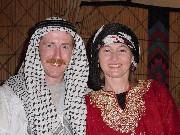 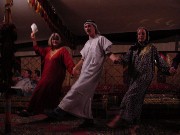 fascinating
look across the milennia at the faces of ancient Palmyra. As the
sun began to set, we headed out into the desert to see the camels (video
- 17 sec.) that were purchased for the Journey
of the Magi 2000 project. At sunset, we headed to the Crusader
castle to get a view of the expanse of old Palmyra's ceremonial center
- quite impressive, reminding us of fascinating
look across the milennia at the faces of ancient Palmyra. As the
sun began to set, we headed out into the desert to see the camels (video
- 17 sec.) that were purchased for the Journey
of the Magi 2000 project. At sunset, we headed to the Crusader
castle to get a view of the expanse of old Palmyra's ceremonial center
- quite impressive, reminding us of 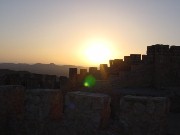 Jerusalem's
Old City (a walled city with its center of worship in one corner and its
cemetery just outside the walls). Starving, we followed the fires
to a nearby tourist attraction, the Bedouin restaurant (theme
music courtesy of U2 - 3 sec.). There, we were treated to yet
another expansive meal of Arabic salads before digging into a large pot
of mansaaf (meat and rice with yogurt sauce) as a musician played
traditional music (audio - 11 sec.).
As we enjoyed fresh fruit and hot beverages, the dancers and more musicians
arrived (video - 6 sec.). Three men,
two women, two drummers, and man playing something like a flute.
After one extended dance, they invited others to join in (which we did).
All in all, a wonderful Syrian desert day. Jerusalem's
Old City (a walled city with its center of worship in one corner and its
cemetery just outside the walls). Starving, we followed the fires
to a nearby tourist attraction, the Bedouin restaurant (theme
music courtesy of U2 - 3 sec.). There, we were treated to yet
another expansive meal of Arabic salads before digging into a large pot
of mansaaf (meat and rice with yogurt sauce) as a musician played
traditional music (audio - 11 sec.).
As we enjoyed fresh fruit and hot beverages, the dancers and more musicians
arrived (video - 6 sec.). Three men,
two women, two drummers, and man playing something like a flute.
After one extended dance, they invited others to join in (which we did).
All in all, a wonderful Syrian desert day. |
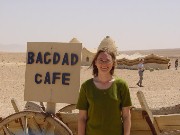 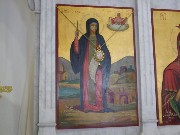 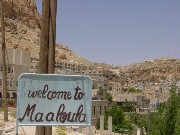 Thursday,
5/30/02: Farewell, Palmyra. We headed on our way to Damascus,
a place we'll be staying for a few nights. That'll be most welcome.
Along the way, we stopped for a rest break at the Bagdad Cafe where we
could also buy t-shirts. Since five of us on the trip went to Iraq
together last May, it was a must-see. We stopped for lunch in the
beautiful Christian village of Ma'aloula, one of several villages in the
area where a dialect of Aramaic is still spoken. It is not exactly
the same as the ancient language spoken by Jesus, but rather a modern version
of it. It is communities like this which are a welcome resistance
against the monolithic global and regional cultures. We also visited
the beautiful little shrine and monastery dedicated to St. Thekla.
Known from the apocryphal Acts of Paul and Thekla, Thekla was a disciple
of Paul's who was threatened with death because of her faith. However,
tradition holds that the earth swallowed her up to save her from that fate,
and a steep canyon marks the site of the miracle. As our Melkite Thursday,
5/30/02: Farewell, Palmyra. We headed on our way to Damascus,
a place we'll be staying for a few nights. That'll be most welcome.
Along the way, we stopped for a rest break at the Bagdad Cafe where we
could also buy t-shirts. Since five of us on the trip went to Iraq
together last May, it was a must-see. We stopped for lunch in the
beautiful Christian village of Ma'aloula, one of several villages in the
area where a dialect of Aramaic is still spoken. It is not exactly
the same as the ancient language spoken by Jesus, but rather a modern version
of it. It is communities like this which are a welcome resistance
against the monolithic global and regional cultures. We also visited
the beautiful little shrine and monastery dedicated to St. Thekla.
Known from the apocryphal Acts of Paul and Thekla, Thekla was a disciple
of Paul's who was threatened with death because of her faith. However,
tradition holds that the earth swallowed her up to save her from that fate,
and a steep canyon marks the site of the miracle. As our Melkite 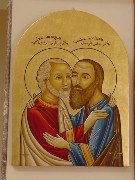 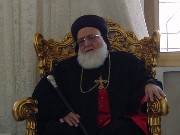 companion
explained, books such as Acts of Paul and Thekla are not canonical (that
is, not part of the Bible), but the stories contained in them that the
church considers worthy of passing along, become part of the Christian
Tradition. Thekla is one such instance, and he shared with us the
prayer of St. Thekla from the Melkite prayer book (audio
- 14 sec.). We then went to visit the Syrian Orthodox Patriarch at
the Monastery of St. Ephraim. He spends his time between the Monastery
and the Patriarchate in Damascus under the title "Syrian Orthodox Patriarch
of Antioch and all the East." Not bad. The name "Syrian Orthodox"
has created some confusion, leading some to believe it is a national church
related to Syria. In Arabic, there is a clear distinction between
the two words translated as "Syrian", so some have begun calling the church
"Syriac Orthodox" to distinguish. The seminary itself is quite new
and is an important center for theological training in this ancient church.
Again, we were privileged to hear the Lord's Prayer in Aramaic. We
arrived in Damascus, where we were greeted with signs announcing a boycott
on US goods in response to American Middle East policy. Now we know
why we've had a hard time finding Coca-Cola in Syria. About half
of our group felt rested enough to attending an ecumenical meeting hosted companion
explained, books such as Acts of Paul and Thekla are not canonical (that
is, not part of the Bible), but the stories contained in them that the
church considers worthy of passing along, become part of the Christian
Tradition. Thekla is one such instance, and he shared with us the
prayer of St. Thekla from the Melkite prayer book (audio
- 14 sec.). We then went to visit the Syrian Orthodox Patriarch at
the Monastery of St. Ephraim. He spends his time between the Monastery
and the Patriarchate in Damascus under the title "Syrian Orthodox Patriarch
of Antioch and all the East." Not bad. The name "Syrian Orthodox"
has created some confusion, leading some to believe it is a national church
related to Syria. In Arabic, there is a clear distinction between
the two words translated as "Syrian", so some have begun calling the church
"Syriac Orthodox" to distinguish. The seminary itself is quite new
and is an important center for theological training in this ancient church.
Again, we were privileged to hear the Lord's Prayer in Aramaic. We
arrived in Damascus, where we were greeted with signs announcing a boycott
on US goods in response to American Middle East policy. Now we know
why we've had a hard time finding Coca-Cola in Syria. About half
of our group felt rested enough to attending an ecumenical meeting hosted 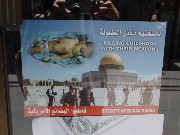 by
the Middle East Council of Churches,
our wonderful guides throughout our stay here. Clergy and laity alike
attended from the various denominations, and the topics ranged far and
wide. The question of proselytism seemed foremost on the minds of
the local clergy, particularly the Orthodox. It seems that from time
to time missionaries come to the by
the Middle East Council of Churches,
our wonderful guides throughout our stay here. Clergy and laity alike
attended from the various denominations, and the topics ranged far and
wide. The question of proselytism seemed foremost on the minds of
the local clergy, particularly the Orthodox. It seems that from time
to time missionaries come to the 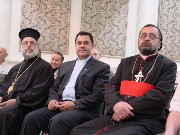 Middle
East seeking to share the gospel among Muslims, but find themselves unable
to translate their message to them - thus, they end up sharing their version
of the gospel with Christians (some call it "sheep-stealing"). Some
shared privately that such folks could present a healthy challenge to the
ancient churches, but there was also great concern about their dismissal
of the ancient churches as not real Christians. Also, many were troubled
by outsiders coming in to change Muslim hearts, failing, and leaving the
local church to clean up the mess and bear the brunt of resentment.
It's clearly a problem that must be addressed. The ecumenical spirit
is impressive. We are talking about how to round out our time here
in Lebanon and Syria with something liturgical. We talked about communion,
but the diversity of practices, theologies, and hierarchies means little
chance we will be able to find common ground. Such is the struggle
for Church unity. Middle
East seeking to share the gospel among Muslims, but find themselves unable
to translate their message to them - thus, they end up sharing their version
of the gospel with Christians (some call it "sheep-stealing"). Some
shared privately that such folks could present a healthy challenge to the
ancient churches, but there was also great concern about their dismissal
of the ancient churches as not real Christians. Also, many were troubled
by outsiders coming in to change Muslim hearts, failing, and leaving the
local church to clean up the mess and bear the brunt of resentment.
It's clearly a problem that must be addressed. The ecumenical spirit
is impressive. We are talking about how to round out our time here
in Lebanon and Syria with something liturgical. We talked about communion,
but the diversity of practices, theologies, and hierarchies means little
chance we will be able to find common ground. Such is the struggle
for Church unity. |
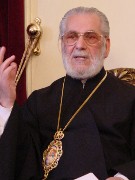 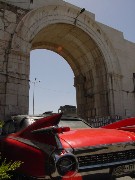 Friday,
5/31/02: Our first visit this morning was with the Greek Patriarch
of Antioch and all the East. When the European countries partitioned
the Middle East, Antioch became part of Turkey - it remains disputed between
the two countries, Friday,
5/31/02: Our first visit this morning was with the Greek Patriarch
of Antioch and all the East. When the European countries partitioned
the Middle East, Antioch became part of Turkey - it remains disputed between
the two countries, 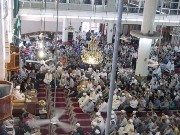 which
means that the Patriarchate has moved out of necessity. Meeting with
him was a truly powerful experience - a humble, theological, faithful,
impressive figure. Reflecting on the question of proselytism, he
called us in the West to recognize that Islam is a reality to be understood,
not ignored. As such, we in the Church must find our language for
speaking with Muslims and sharing our faith - conversion is the work of
the Holy Spirit, but proclamation and witness are ours. As such,
our whole language must change. We could've listened to him dispense
wisdom for hours, but we had another important appointment to keep - this
one with the Grand Mufti of Syria, Mufti
Kuftaro, for Friday lessons. The Middle
East Council of Churches had set this up with the aging Islamic leader
who has made his career out of bridging Muslim-Christian relations.
We met with his son as the congregation prayed, hearing about the mosque's
benevolence society and its work. The women headed up to the second
floor with the other women while the men headed down front to sit with
the Mufti. He spoke as we listened to translation which
means that the Patriarchate has moved out of necessity. Meeting with
him was a truly powerful experience - a humble, theological, faithful,
impressive figure. Reflecting on the question of proselytism, he
called us in the West to recognize that Islam is a reality to be understood,
not ignored. As such, we in the Church must find our language for
speaking with Muslims and sharing our faith - conversion is the work of
the Holy Spirit, but proclamation and witness are ours. As such,
our whole language must change. We could've listened to him dispense
wisdom for hours, but we had another important appointment to keep - this
one with the Grand Mufti of Syria, Mufti
Kuftaro, for Friday lessons. The Middle
East Council of Churches had set this up with the aging Islamic leader
who has made his career out of bridging Muslim-Christian relations.
We met with his son as the congregation prayed, hearing about the mosque's
benevolence society and its work. The women headed up to the second
floor with the other women while the men headed down front to sit with
the Mufti. He spoke as we listened to translation 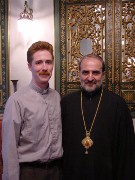 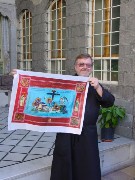 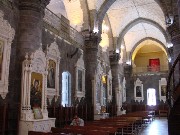 via
headphones (unfortunately not very clear for the women), speaking about
the need for Muslims to follow the way of peace faithfully. It was
mostly a word of folk-wisdom from our perspective, but people were hanging
on his every word. After he had spoken for an hour, one of our group
was invited to speak. Rev. Dr. Gary Burge, Professor of New Testament
at Wheaton College and the President
of Evangelicals for Middle East Understanding,
had been asked to share a message to the people. He did so, preaching
on the story of the Good Samaritan (Luke 10). As worlds collide these
days, the need to break down barriers and work past stereotypes and preconceptions
is more necessary than ever. It was truly an unique moment - people
hanging on Dr. Burge's every word, grateful for the opportunity to break
down boundaries and to find ways to forge a future together - not boiling
down our distinct faiths so that they become bland versions of the original,
but finding the places of contact such that we can live together in peace
and understanding. From there, we headed off to the Melkite Patriarchate.
Centered in the Old City of Damascus, along the Street called Straight
(the site of the scales falling from St. Paul's eyes - Acts 9), this is
the head of the Greek Catholic church throughout the world. Unfortunately,
the Patriarch was in the States opening a new church there. We met
with one of his bishops, a great treat for us - and especially for the
Melkite priest in our midst. via
headphones (unfortunately not very clear for the women), speaking about
the need for Muslims to follow the way of peace faithfully. It was
mostly a word of folk-wisdom from our perspective, but people were hanging
on his every word. After he had spoken for an hour, one of our group
was invited to speak. Rev. Dr. Gary Burge, Professor of New Testament
at Wheaton College and the President
of Evangelicals for Middle East Understanding,
had been asked to share a message to the people. He did so, preaching
on the story of the Good Samaritan (Luke 10). As worlds collide these
days, the need to break down barriers and work past stereotypes and preconceptions
is more necessary than ever. It was truly an unique moment - people
hanging on Dr. Burge's every word, grateful for the opportunity to break
down boundaries and to find ways to forge a future together - not boiling
down our distinct faiths so that they become bland versions of the original,
but finding the places of contact such that we can live together in peace
and understanding. From there, we headed off to the Melkite Patriarchate.
Centered in the Old City of Damascus, along the Street called Straight
(the site of the scales falling from St. Paul's eyes - Acts 9), this is
the head of the Greek Catholic church throughout the world. Unfortunately,
the Patriarch was in the States opening a new church there. We met
with one of his bishops, a great treat for us - and especially for the
Melkite priest in our midst. 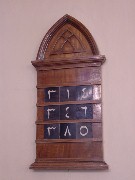 The
bishop gave him an altar cloth, newly blessed by the The
bishop gave him an altar cloth, newly blessed by the 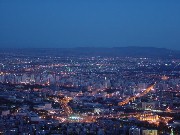 Patriarch.
Each cloth contains a relic, meaning that when the congregation celebrates
the eucharist, they are in communion with the Patriarch as well as the
communion of saints. We shared with the bishop our work in the Jenin
and Nablus areas, particularly with the Melkite communities. We visited
the Church of the Patriarchate and noted its very high pulpit, reminiscent
of John Calvin's old church in Geneva. As we prepared to leave, the
bishop called Marthame over, handing him an altar cloth like the one he
gave to the Melkite priest. "This is for you," he said. "This
means you are in communion," said the priest. It was a very moving
moment, one hinting at a rich and beautiful unity of the Church.
We headed down Straight Street, winding our way through the narrow streets
and past the relic American cars until we arrived at the Presbyterian church,
meeting with Pastor Boutros. We had a wonderful meeting together,
heading up to get a mountain view of Damascus (video
- 17 sec.) before going back to our hotel for dinner. This meal was in
the rotating restaurant - this hotel has more restaurants than all of Jenin. Patriarch.
Each cloth contains a relic, meaning that when the congregation celebrates
the eucharist, they are in communion with the Patriarch as well as the
communion of saints. We shared with the bishop our work in the Jenin
and Nablus areas, particularly with the Melkite communities. We visited
the Church of the Patriarchate and noted its very high pulpit, reminiscent
of John Calvin's old church in Geneva. As we prepared to leave, the
bishop called Marthame over, handing him an altar cloth like the one he
gave to the Melkite priest. "This is for you," he said. "This
means you are in communion," said the priest. It was a very moving
moment, one hinting at a rich and beautiful unity of the Church.
We headed down Straight Street, winding our way through the narrow streets
and past the relic American cars until we arrived at the Presbyterian church,
meeting with Pastor Boutros. We had a wonderful meeting together,
heading up to get a mountain view of Damascus (video
- 17 sec.) before going back to our hotel for dinner. This meal was in
the rotating restaurant - this hotel has more restaurants than all of Jenin. |
|
|